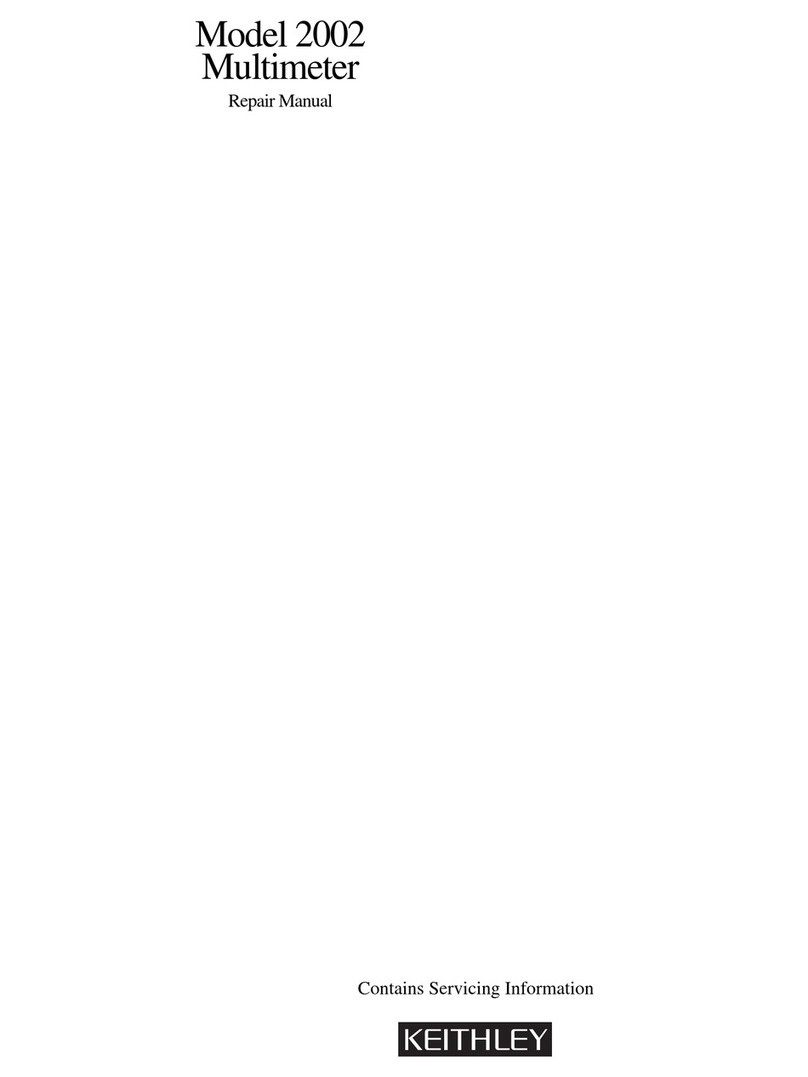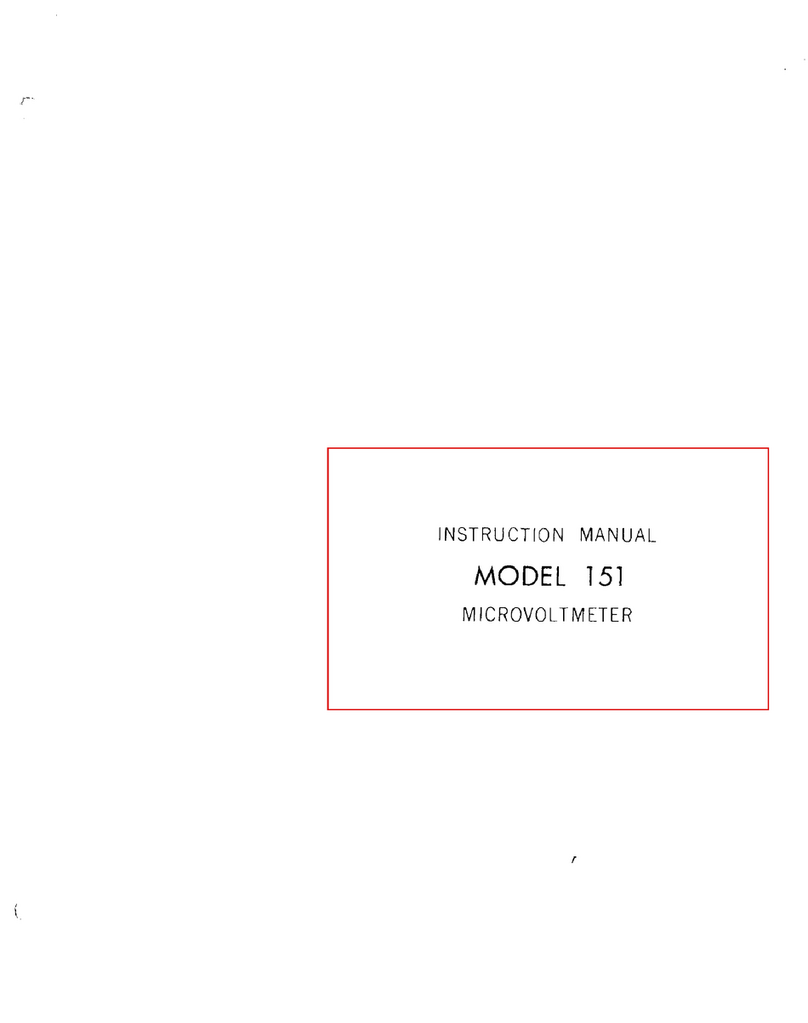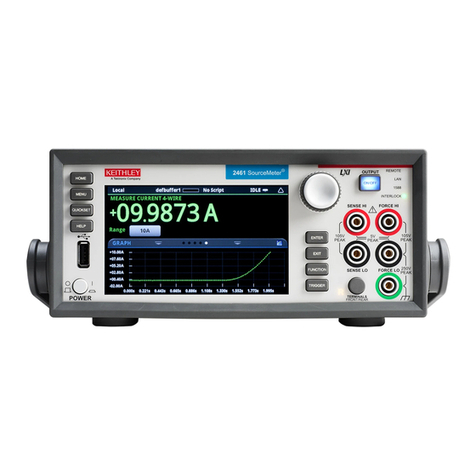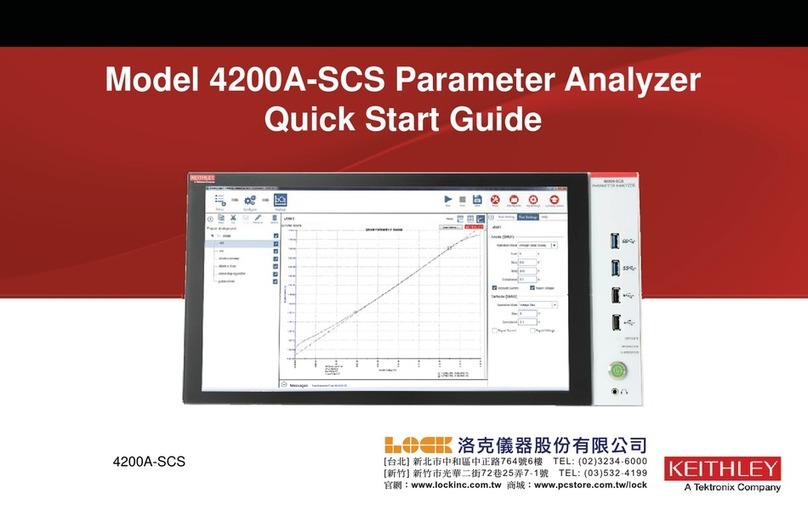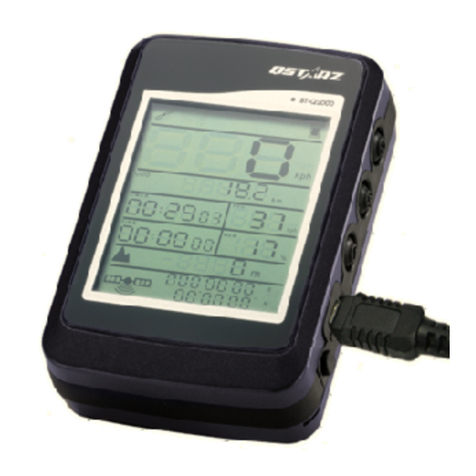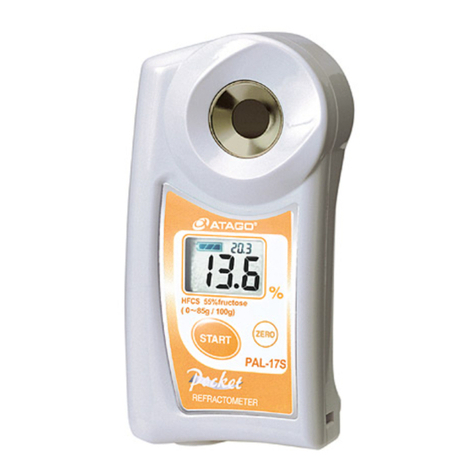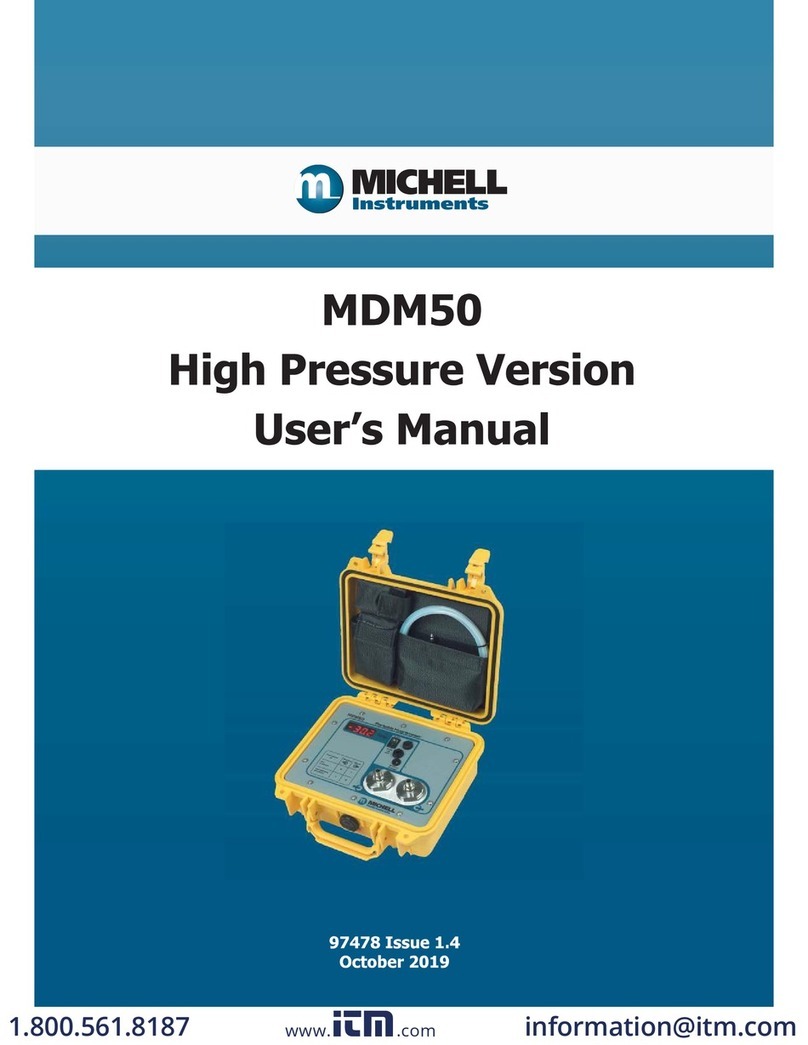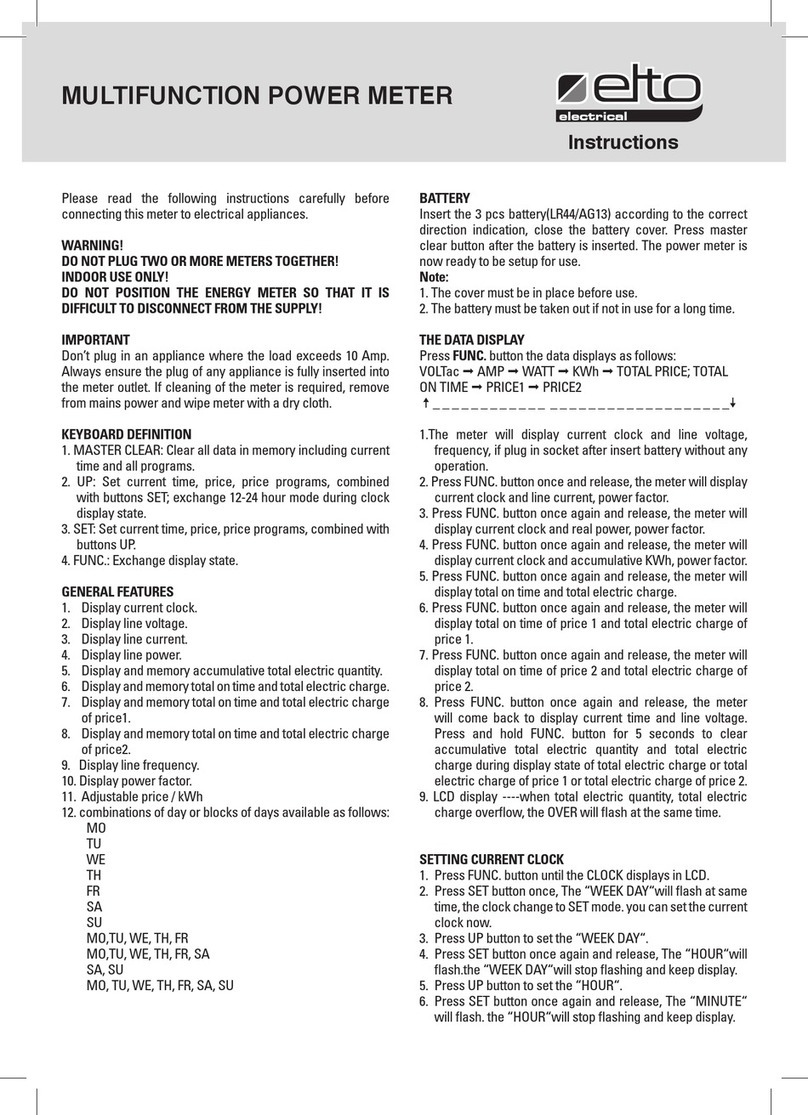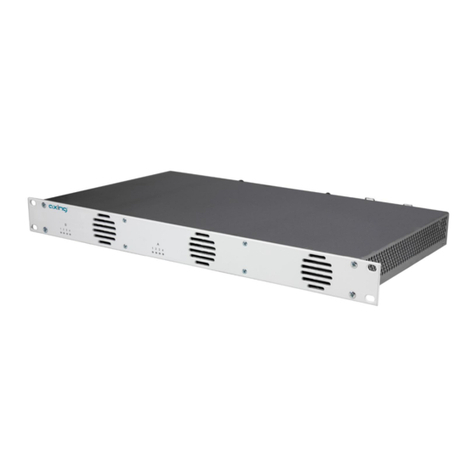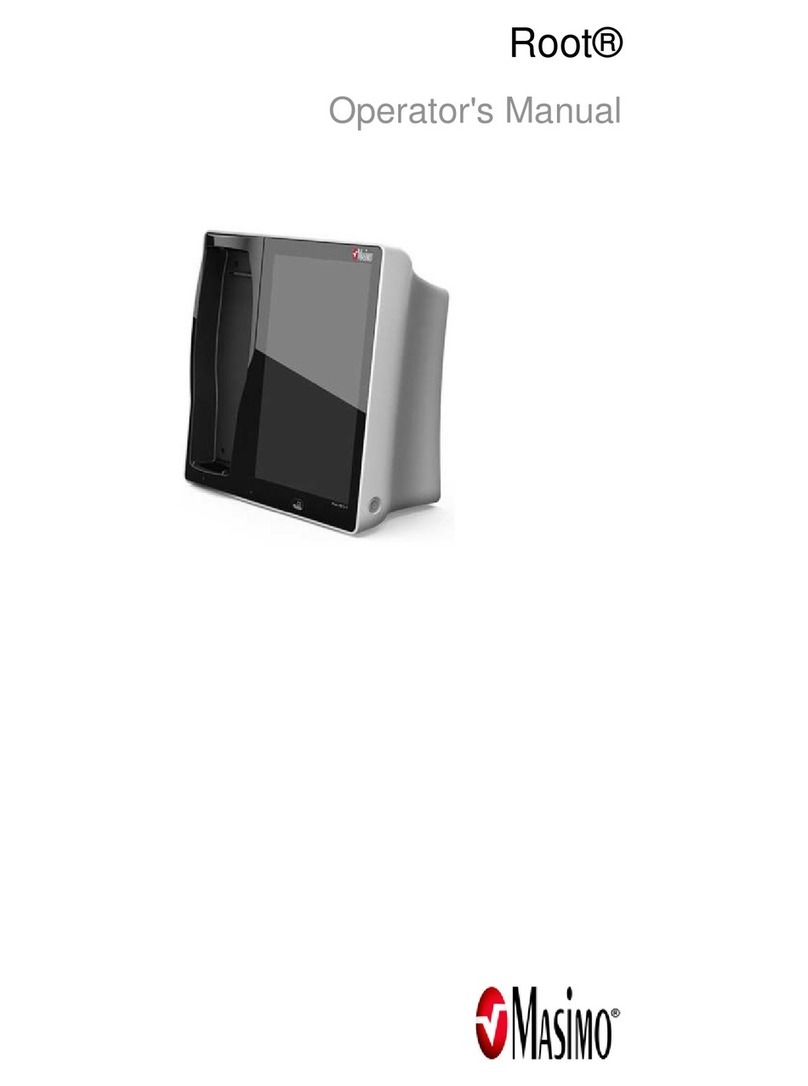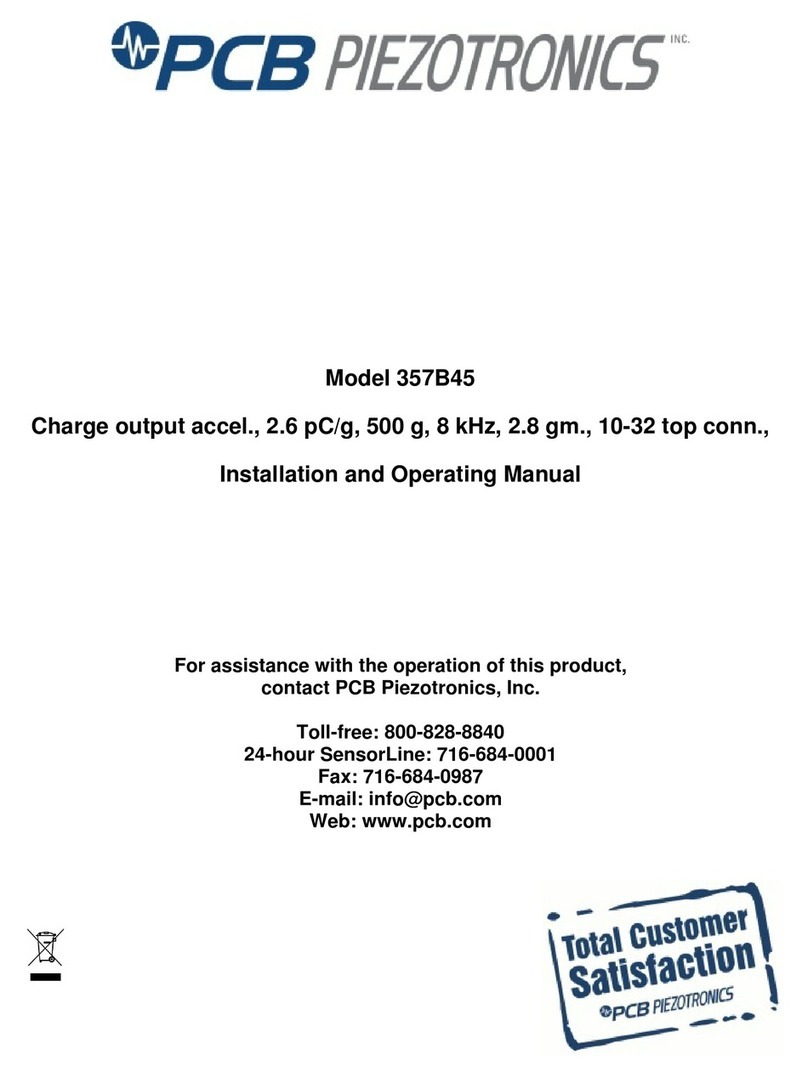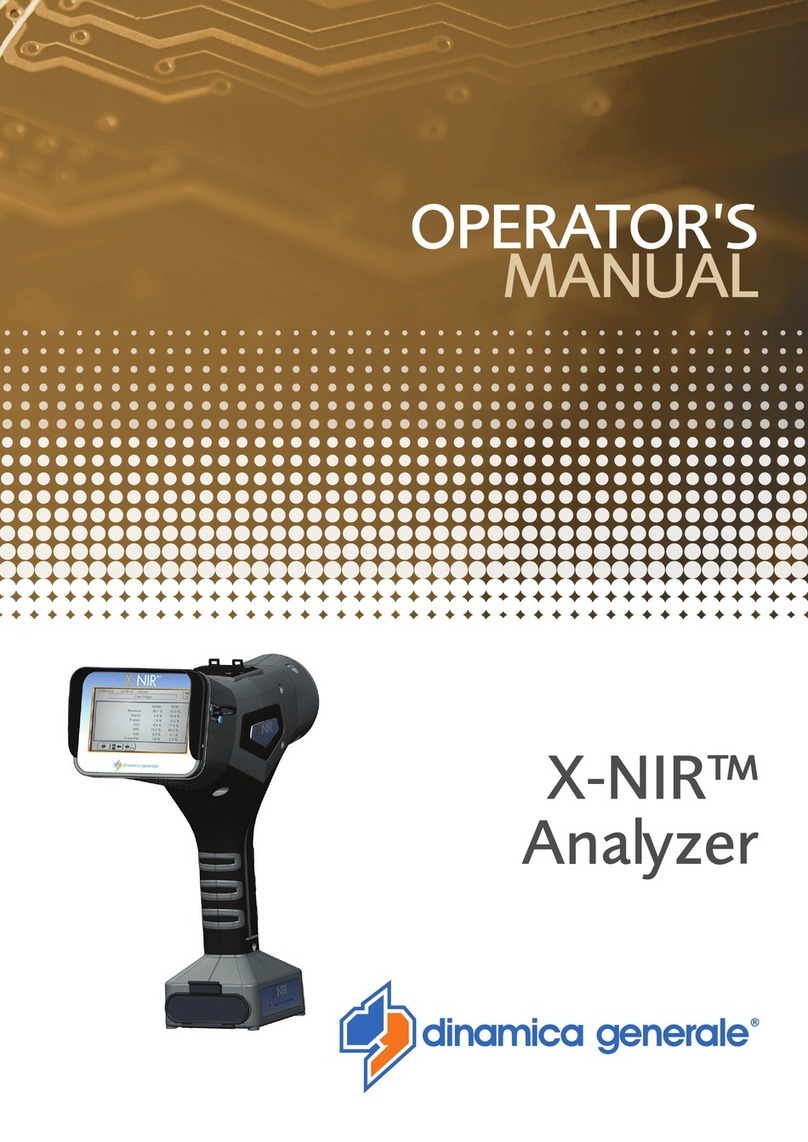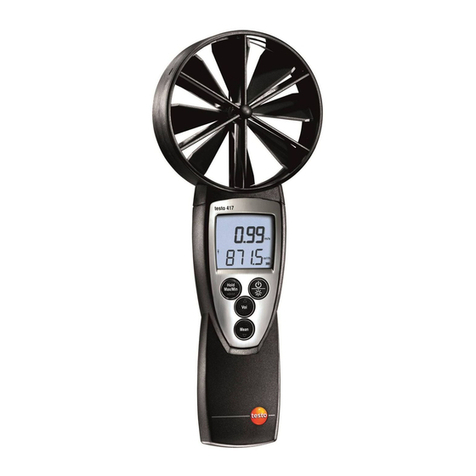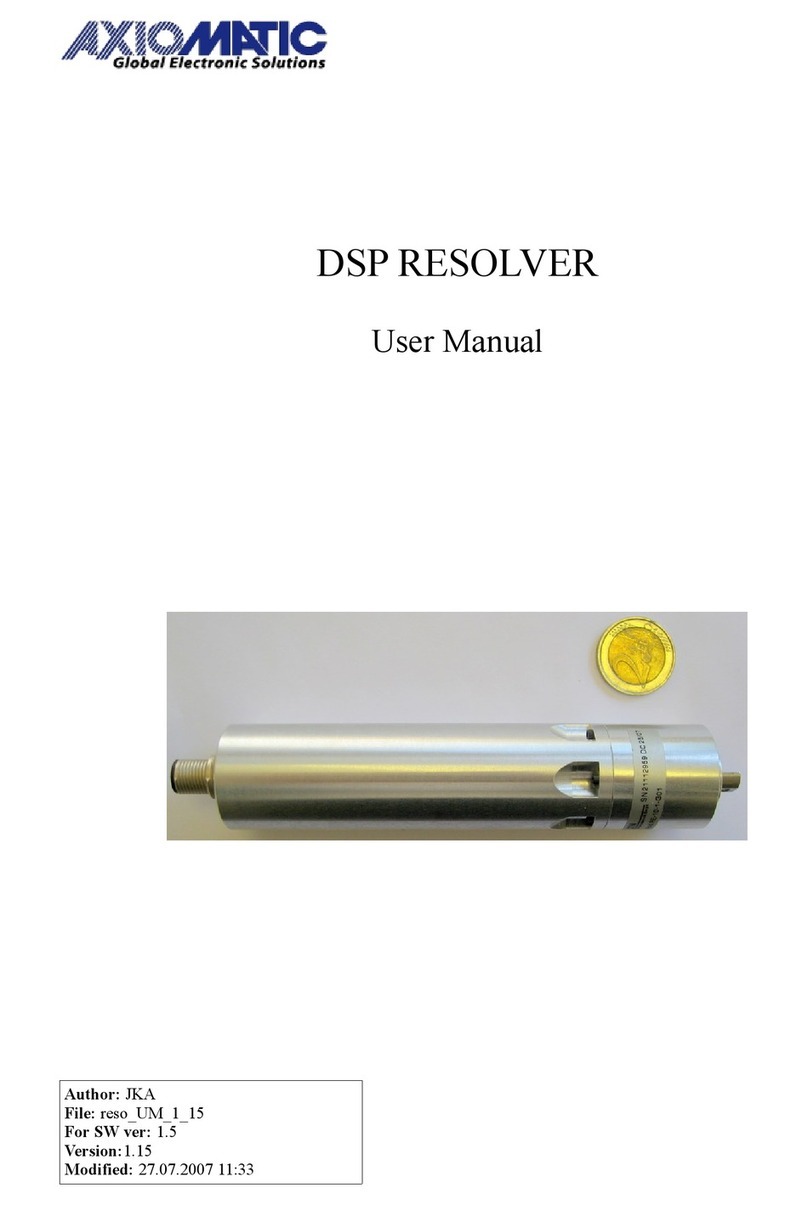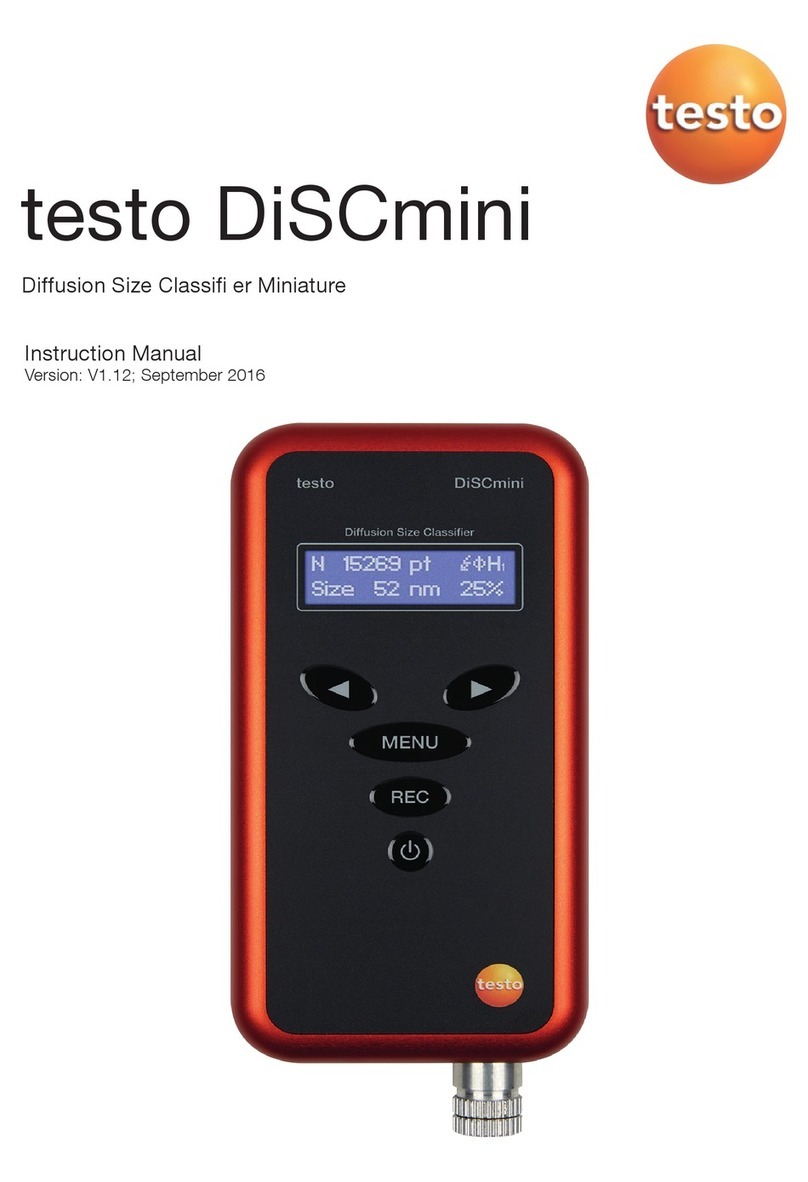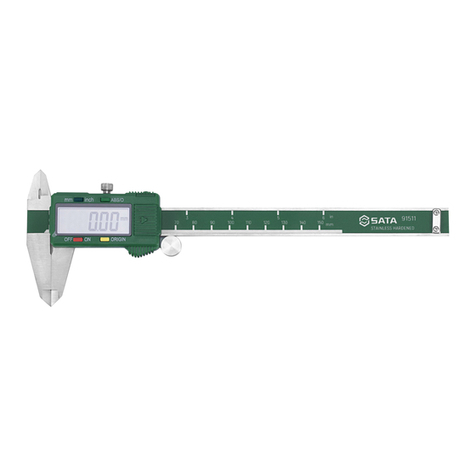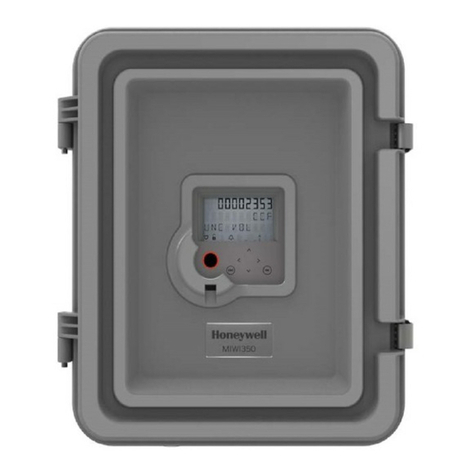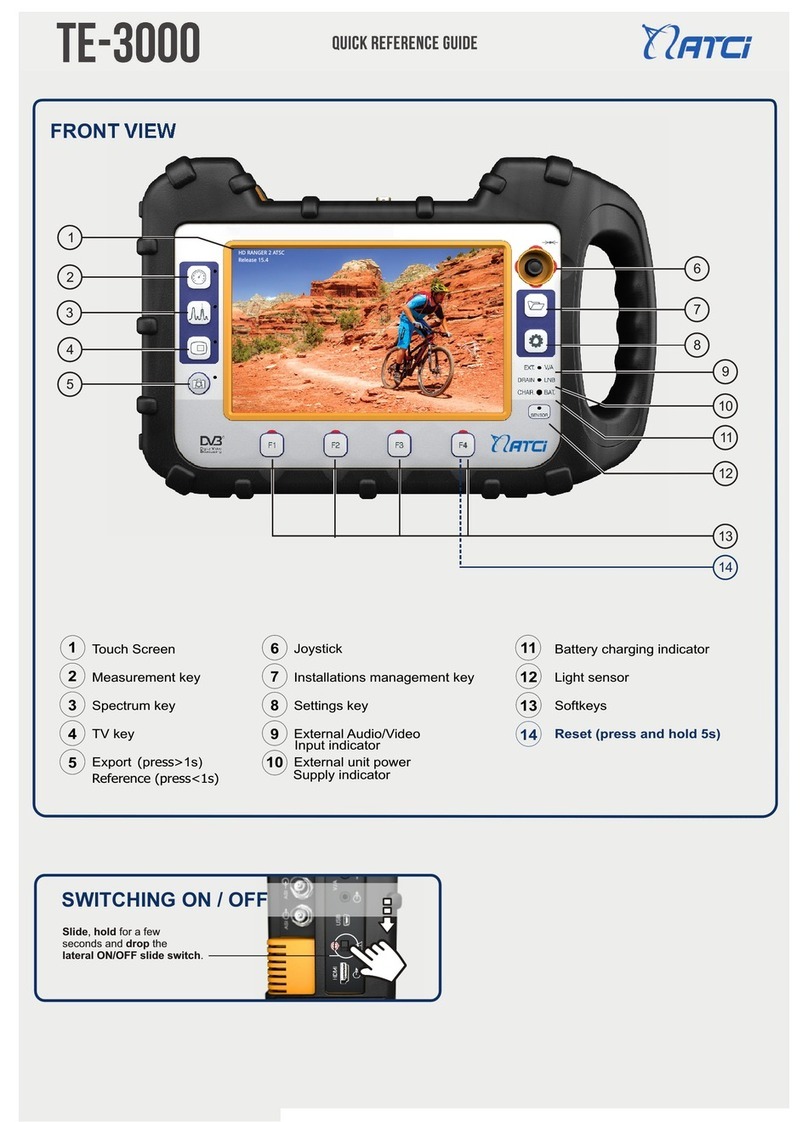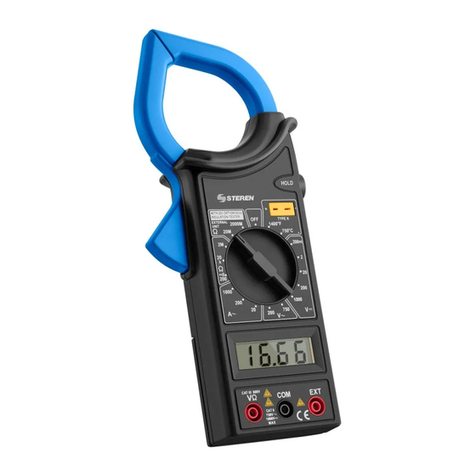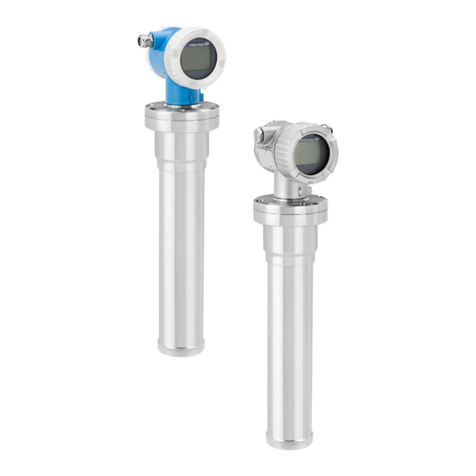Keithley 445 User manual

CONTENTS
SBCCiOU
SPEClFIMTI(JNS ---------------_--------------------------
1. GENERAL DESCRIPTION ------------ -------------------
2. 'PEmTION ---------------_-_--_______________I____---
3. CIRCUIT DESCRIPTION __-_-------------------------------
4. ~p~‘-~LE PARTS ________________----_____I________-_
5. C&TBmTl,,N __-______---__-__----------------------------------
SCHEMATICS __-_----_------__---______ll______l_____------
PM,.2
ii
1
3
11
29
51
57
MODEL 445
PRINTrn JUL 74
0174

iLLUSTF.ATIONS
ILLUSTRATIONS
Fiu. No.
1
2
3
4
5
6
7
8
9
10
11
12
13
14
15
16
17
1B
19
20
21
22
23
lb
25
26
27
25
:i
31
32
33
::
Title Page
Front Panel. 1
Front Panel Conrrols. 2
Rear Panel. 2
Triaxial Receptacle. 3
Reading Time. 4
Digital Display. 5
Prfnter/Control ConneccLr. 9
Timing
Diagram. 10
Feedback titer. 11
Range Calibration. 11
Overall Block Diagram. 12
Autoranging Block Diagram. 13
A-Lo-D Converter Diagram. 14
Delay Hold Diagram. 15
Integrator Block Diagram. 15
zero cro**ing DetacLor.
15
Model 4401 Buffer stage. 17
Chassis, Top View. 19
PC Board Locationa. 20
Componanr Layout, PC-207. 21
cMnponenc Layout, PC-208. 21
COmponent Leyout, PC-209. 22
Component Layout, PC-212. 22
Component Layour. PC-214. 23
cmponent Layout, PC-217. 23
Colnponent LayoUr, PC-218. 24
component Layout, PC-219. 24
component
Layout,
PC-221. 25
corQpon.nt Layout. PC-229. 27
Componenr Layout, PC-230. 27
Mechanical Assembly. 31
Test Equipment Set-up for A/D Calibration. 54
AID
Converter Zero Adjuetmenrs 55
Test Cover Template, Top Panel. 57
Teat
Cover Template, Bottom Panel. 58
0714

SPECIFICATIONS HODEL445
SPECIFICATIONS
RANQE:
lo-’ amper. full scale (lo-” ampere. least
significant digit) to 104 ampsra in eight decade
ranges with 100% ov.rr.nging on all ranges.
DISPLAI: Four digits from 000 to 1999: range ~4.
pon.nt digit from 2 lo 9: paerity. overload and
Range Changing indication.
POLARITY SELECTION: Automatic.
RANQE
SELECTION:
Automatk: Range change possible after each A to
D conversion. An undrrrangscondition (<lOOdigits)
causer one range change to next more sewdive
rsng.. An overr.nge condition (21999 digit.) on
any range ca”ses rang. change to IO-’ A range.
Mmu~l: Front panel swi1ch.s permit manual r.nga
control.
ACCURACY AND RESWNSE TIME:
I~ C,llbr.l~.l1.c1011 IllT .n*.nlb. bl.m,l Id,“Itmmnt.On10.. to ,w
&lw,,. ran,,, to, loc.1,~1.llO”.
1. I1 dW1“4” ‘1l1.1WI .“d 100Wol.l.dS Y”Ml”, m. mow
1. WI” “0 10 $00 P’cOlll.as %h”nlm, tn. l”D”l l * rllt” wt.
FILTER: Improves .c rsiection by Ikngthening rise tim.
to approximately 3/4 son lO-’ to IO-* A ranger.
LEN0
DRIFT: Lass than 0.5% of full scale per week;
le.1 than O.OS%/‘C. after %.hour warm-up with
source volt.ge greater than 2 volts.
DISPLAY RATE: 24 r..dings per
second
maximum (20
per second with 50+lz units), adiusbble toapproxi.
mstely 1 reading per two seconds.
With Filter in. m.ximum display rate is abeut l/s.
INPUT VOLTAQE DROP: Less than 1 millivolt for full.
scale display on all r.ng.s when properly zeroed.
LINE
FREQUENCV REJECTION: 60 dS (ratio of peak.
to.pe.k current of power line frequency or multiple
which will cause less than 1 digit of error, to that
error). 100 dEon LO-rto 10-v A rmges with Filter
in. P..k input current should not .xc.ed 20 mA.
MAXIMUM INPUT OVERLOAD: 1000 volt. using .
Keithlay or other current lim#t.d (up to 20 mifli.
amperes)
High Voltage Supply with Model 445 in
autorange mod.. Inst.ntaneous input current must
never exceed 125 m~lliamp.res.
ANALOG OUTPUT: tl volt from . 500.ohm sourc.
for full.scale display. Maximum output. 1 millian.
per*. Output polarity is opposit. input polarity.
PRINTER OUTPUTS AN0 REMOTE CONTROLS:
Printer Output.: SCD positive output represents
each of the four digits, rang.. polarity. overrange.
r.nge changing and zero check. Standard cod. is
1.2.4.8. “0”<+0.4 volt: “l”>+ 10 volts at up to
one milliampw.: O=OOOO.
Print bmm.nd A: Positive pulse of 14 volts from.
2200.ohm source with 1 volt per mlcros.cond rise
time. 100 mkroseconds minimum pulse width. Print
commrnd given after each A to 0 conversion.
Print Commend 0: Same .s Print Command A ax.
cept pres.nt only when displaying an onrsnge
reading.
Remote Control.:
Hold # 1: Closure* to ground inhibits A to D
conversion .t that instant.
Hold # 2: Closure* to ground inhibits A to D
conversion .fter r..ding h.s been compl.t.d.
Trigger: Cbsure* to ground initiates one conv.rsn)n
when in Hold #2. Integration period starts 8.3
millisecond. (10 milliseconds on 50.H~ models)
.fter “Trigger” or r.le.se of Hold # 2.
R.nSr HoM: Closure* to ground prevents range
change.
2ero Check: Closure* to ground places instrument
in zero check mode and prewnts range change.
101 Range: Cbsure’ to ground places instrument
in 10-a ampere r.nge and holds until lo-* Range
rolnsed.
ISOLATION: Circuit ground to chassis ground: Greatsr
th.n l(r ohm. shunted by .02 microfarad. Circuit
ground mey bi floated up to 100 volts with respect
to ch.s.is ground.
COMMON MODE REJECTION: 100 V de or 200 V
pe.k.to.p..k rt line frequency will not affect resdmg.
CONNLCTORS: Input: Teflon.insul.ted triaxi.1. Analog
output: Amphenol SO.PCZF. Printer outputs and
rrmote controls: 50.pin Amphenol Micro.Ribbon..
Low md C.S. ground: Binding posts.
FOWEL
105.125 or 210.240 volts (switch selectsd).
60 Hz. 50.H~ models .v.il.bl.. 30 watts.
DIMENSIONS. WEIQHT: 5’1,” high x 19” wd. by lo”
deep; nrt weight, I5 pounds.
ACCESSORIES SUPPLIED:
Model 4451 Input Cable: 48” triaxial cable wth
triaxi.1 connector and 3 alligator clips.
M.ting digit.1 output connector.
IV
0874

MODEL445
SECTION 1. GENERAL DESCRIPTION
GENERALDESCRIPTION
1-1. GENERAL. The Model 445 is B sensitive Automatic d. Digital Display. The digital display provides
Ran
lo- 8
ing Digital Picoammeter with eight ranges from
to 10-2 ampere plus 100%cwerranging. 3 digits with lo-= ampere resolution.
e. Variable Dieplay Kate. A front panel DISPLAY
RATEcontrol adjusts from 24 readingslsec. to 1 read-
l-2. FEATURES. ing/Z eec, to accommodate the mode of data retrieval.
a. Stability. Zero drift with time is less than 1 f. Autorsnning. Autorange circuit sense8 the in-
digit per day; drift with temperature is less than one put current and automatically selects the proper
digit per O/C, making frequent adjustment unnecessary. range far each meaeurement.
b. Overload Protection. A transient overload of g. Complete BCDOutput and Control Lines. Binary-
1000 volts at up to 20 r,A will not damage the instru- Coded-Decimal Outputs are provided on a rear panel
nlent. connector for significant digits, range, polarity,
overrange, and zero check. Cantrr,l lines are also
C. Damping. A front panel FILTER Switch selects
additional damping of noisy signals on the 10-7. lo:*. provided for remote control of ranging and A/D conver-
*ions.
and 1O-g amp& r&es. - - ,
TABLE
l-l.
Front Panel Contr018.
Control Functional Description
POWERwitch (S102) Controls power to instrument.
ZEROCHgCK(S1204) Selects Zero Check Made.
ZEROADJUST(R1207) Adjusts the zero offset.
FILTER Switch (S1201) Selects additional filtering.
RANGE-HOLD/AUTOMATIC(51203) Selects HOLDor AUTOMATICmodes.
RANGE- lo-Z/DOWN (51202) Permits manual range selection.
DISPLAY FATE (R1237) Adjusts the AID conversion rate.
Paragraph
2-3, B
2-3, b
2-3, c
2-3, d
2-3, a
2-3, f
2-3, 8
0971 1

GENERALDESCRIPTION MODEL445
ZEROADJUST ZEROCHECK
Control R1207 Switch S1204
I I
PO&R DISPLA; RATE PI<TER RANGE P&&E
Switch Switch 51205 Switch CHANGING HOLD/AUTO 10-2/DowN~
s102 51201 Lamp DS1201 Switch 51203 Switch S1202
FIGURE2. Front Panel Controls.
TABLE 1-2.
Rear Panel Terminals.
Terminal
INPUT Receptacle (51213)
LO Binding Post (51215)
GNDBinding Post (51217)
PRINTER/CONTROLConnector (51214)
ANALOGOUTPU'I(51218)
Functional Description
Input connector, triaxial type.
Input LO connector.
Chassis Ground connector
Provides BCDoutputs and control lines; 50 pins.
Analog Output connector, Mates with Keithley
Part NO. a-33.
Paragraph
2-1, a
2-1, a
2-1, a
2-8, a
2-7 I
2 0971

MODEL445 OPERATION
SECTION 2. OPERATION
1NPUT
LOW
HIGH
CASE

OPERATION
!L
of a
al 2
Accurecv. The accuracy is specified in terme
percent of reading on esch range. A” addition-
1 digit is specified since the A/o conversion
has-e” inherent 2 1 digit uncertainty. Noise and
saurce~resistance conditions should be evaluated es
additianal meeeurement considerations.
a. Source Resistance.
The value of eowce resist-
ance can affect the measurement if the loading effect
of the picoammeter is significant. To avoid a de-
gradation of zero drift, the picoammetee range should
be selected so that the range feedback resisrar is
much lesa than the e~urce resistance. The zero drift
epecificseio” is valid only for e~urce voltagee greaf-
er the” 2 volts.
f. Overloads. A unique input circuit provides
complete overload protection with feet recovery. The
maximumoverload is 1000 volts using e current limit-
ed supply (up to 2OmA)such as Keithley Models 240.4,
245, or 246.
Instantaneous input current mwt “ever
exceed 125 milliamperes. With a” input voltage up
to 1000 volts use e current limited supply or a ser-
ies limiting resistor (8000 ohms minimum).
MODEL445
g. Reading
Time.
The time interval for a new
reading to take place depends on the Model 445 front
panel Settings as well as the chareceeristics of the
input signal. The various time intervals which co”-
etitute the total reading time are described es
follows. The intervals are graphically shown in
Figure 5.
1. T1 = A/D Conversion Time until first range change.
2. T2 = Total Time for all successive range changes.
3. Tj
= A/D Conversion Time to first an-scale reading.
4. Tq = Total Settling Time until reading is final.
h. Off-Ground Measurements. The Model 445 can be
used far off-ground meeeurements with the circuit low
floated up to 100 volts with respect to chassis ground.
Circuit low to chassis ground isolation is greater
then 106 ahms shunted by .02 microfarad. Whenmaking
off-ground meeeuremente discannect the LO to GND
shorting link on the rear panel. A triaxial cable
should be used to maintain noise shieldine and to
provide ueer safety., The BCDautputs are”co”“ected
to circuit low and therefore muet be used with de-
vices which ce” be Operated off-ground.
TABLE 2-1.
Typical Reading Time With Filter “OUT”.
Input
Initial Sampling Range Ranging Final Range Settling Total
Signal Range Time Tl Sec. Changes Time T2 Sec. Time Tg Sec. Time Tq Sec. Time Sec.
10-9 A 10-2 A .042 7 .294
10-g 10-2 (1) (7) .042 (1) .120 (3) .498 (12)
A A
.042
(1) 6 .252 (6) ,042 (1) ,060 (3) .396 (11)
10-7 A 10-2 A .042 (1) 5 .210 (5) ,042 (1) .OlS (3) .312
10-6 10-2 (10)
A A .042 (‘1) 4 .168 (4) .042 (1) ,015 - .267 (6)
10-5 A 10-2 A .042 (1) 3 .126 (3) ,042 (1) ,012 - .222 (5)
10-4 A 10-2 A .042 (1) 2 .084 (2) .042 (1) .003 - ,171 (4)
:;I; ; .042.042 (1) 01 ,0420 (1) ,042,042 (1) ,003.003 -- ,129,087 (3)
(1) (0) (1) (2)
PIGoRE 5. Reading Time.
4 0971

MODEL445 OPERATION
2-3. FRONTPANELCONTROLS.
a. POWERSwitch (S1021. This switch controls the
line power to the instrument. A rear panel fuse
PlOl protects the instrument in case of malfunction
of the power supply or power switch.
b. ZEROCHECKSwitch (S1204L This switch selects
either "NORMAL"or "ZEROCHECK"modes of operation.
I" "ZEROCHECK""asitio", B relay is activated which
places a short across the feedback of the picoammeter.
Zero Controls R1238 and Rl207 ca" be used to adjust
the zero offset as necessary.
c. ZEROADJUST(R12071. This control provides
"FINE" adjustment of the zero offset. The internal
zero control Rl23S provides "COARSE"adjustment.
d. FILTER Switch (51201). This switch selects
either mininu,, damping ("OUT" position) or additional
damping ("IN" position).
A
more complete diacussio"
of the "FILTER" mode is give" L" paragraphs 2-2, c
and 2-2, g.
e. RANGE- HOLD/AUTOMATICSwitch (51203). This
switch selects automatic re."e.i".z weratio" in "ADTO-
_ _
MATIC" position or manual ranging in "HOLD" position.
I,, "HOLD", the range is held at the existing range
displayed until the switch is changed or the range
is manually changed by either S1202 or the external
control lines.
f. RANGE- 10-2/DOWNSwitch (51202). This switch
is a nomentary-contact, "armally open switch for ma"-
ual range changes. This switch should be used with
Switch 51203 in the HOLDposition. When Switch S1202
is nmentarily set to "lo-2", the Picaawneter resets
the range display t" 10e2. However, each time the
switch is set to "DOWN"Lmsition. the Dicoammeter down
w to a more sensitive range: The'sequence af-
dawn ranging would be typically 10-2, lo- , 10 4, 10-5,
;riO$ith a reset after 1O-g range is reached, that
) 10-9, 10-q.
g. DISPLAY RATE (R12371. This control adjusts the
A/D Converter conversion rate from 24 readingslsec.
(MAX) to 1 reading/Z sec. (approx).
2-4. OPERATINGPROCEDURE.
a. Preliminary Pracedure.
1. Check the 117-234" Switch (SlOl) on the rear
panel for proper line voltage.
2. Check for proper rated fuse.
3. Connect the power cord, place the POWERSwitch
ON, and allow a 30-minute warmup for critical meas-
urements.
4. Adjust the ZEROContra1 (R1207) as necessary.
Zero is indicated by alternately flashing + polarity
lights.
5. Connect the source as described in paragraph
2-l.
b. Measurements. The Model 445 measures current
over a full-ran e
6 from 10 milliamperes (10m2A) to 1
"anoampere (lo- A) with resolution to 1 picoampere
(lo-12A). The display will indicate either a posi-
tive or negative input current autamatically. (A
p"sitive current is defined as a positive "conven-
tional current" applied at Input High with respect
to Input LOW).
2-5. DIGITAL DISPLAY. The display has three digits
plus one for overrange indication. The range is
displayed in scientific notation where the exponent
is automatically displayed for ranges 10-2 through
10-9 amperes, To interpret the display refer LO
Figure 6. A" overload condition will cause the dis-
play cubes to blank o"t so that "o ambiguous display
is possible.
This
situation is described under 2-4,
d Autoranging.
How to Interpret the Digital Display
The reading shown in Figure 6 above should be
interpreted as follows. The polarity is dis-
played by a lighted "f" or "-" indicator. The
decimal point remains fixed with respect to the
digits. I,, the example, the reading is 1.676
(three digits plus a "one" for overrange). The
range multiplier is 10-9 (the exponent is a"to-
matically selected by the autorangi" circuit).
The complete reading is +1.676 x lo- 8 amperes.
FIGURE6. Digital Display.
0971 5

OPERATION MODEL445
TABLE 2-2.
Output Information and Controls.
lode1 4401 Printer Output Cards: Provide SCDoutp"t
and external control of Model 445; may be purchased
installed or separately for field installation (no
wiring required).
Printer Outputs: SC0 pwitive o"tp"t represents
each of the four digits, exponent, range, zero,
polarity and averrange. Standard code is l-2-4-8.
"O"< +0.4 volt; "1" 5 +lO volts at up to one milli-
ampere; O=OOOO.
Print Command: Positive pulse of 14 volts from a
2200-ohm source with 1 volt per microsecond rise
time, 100 microseconds minimum pulse width.
Remote Controls:
Hold #l: Closure to ground inhibits A to D conver-
sion at that iridtant.
Hold 82: Closure to ground inhibits A to D canver-
sion after reading has been completed.
Trigger: Closure to ground initiates one conversior
when in Hold 112. Integration period starts 8.3 ms
(10 ms on SO-Hz models) after
"Trigger"
or release
of Hold i/Z.
Connector: SO-pin Amphenal Micro-Ribbon mounted on
Model 445. Output mating connector supplied with
4401.
NOTE
The term "Closure to Ground" or "Grounded control
line" means a short to commn directly or
through
a saturated NPN transistor (VC, <
+0.4V).
Only
the "COMMON"as supplied at the PRINTER/CONTROL
connector should be used for closures to ground.
TABLE
2-3.
Full Scale Magnitude.
Connector
Pi" No. Output Decimal Digits
1 .l x 10" 1
2 2
x 10"
2
26
4 x 10"
4
27
8 x 10" 8
3
1 x 101 1
4 2
x 101
2
28
4 x 101
4
29 8 x 101 8
5 1 x 102 1
6
2
x
102
2
30 4
x
102 4
31 8 x
102
8
0971

MODEL445 OPERATION
2-6. A!JTORANGING.The sutomatic ranging feature of
the Model 445 permits rapid measurements of B wide
range of currents.
b. Output Codes and Levels. The PRINTER/CONTROL
0ut”uts are Sinarv Coded Decimal sianels with l-2-4-
8 S&da-d Code. . The Standard signal levels are as
follows:
a. AUTOMATICMode. In this made the Model 445 will
automatically select the full-range that permits a
display from 0.100 to 1.999. The Model 445 changes
range in decade steps from .a less sensitive range to
a mare sensitive range. This process is defined as
“down-ranging”. If the input current causes the dis-
play to exceed 1.999, the” the Model 445 will a”to-
matically change to “10-2” range and “down-range”
until the display Is between 0.100 and 1.999.
1. DOWNRange Control. The “se of Switch S1202
permits manual range changing. This switch is a
momentary-contact type switch. Each time the switch
is depressed to “DOWN”position, the range will
“down-range” from a less sensitive range to a more
sensitive range. When the 10-V range is reached,
actuation of the switch will cause the range to go
to 10-2 or “reset” position.
2. 10-2 Range Control. When switch 51202 is set
to “10-Z” position, the range will be “reset” to
the lo-2 range regardless of the current input.
Once the switch is released the Model 445 will re-
vert to normal operation.
b. HOLDMode. When switch 51203 is set to “HOLD”
position, the full range of the instrument will hold
regardless of the input current. This switch posi-
tion inhibits the operation of the DOWN/lo-2 switch.
NOTE
If the input current exceeds 1.999 for the
range in “HOLD”, the display tubes will
blank indicating a” overload on that range.
If Switch 51203 is set CO“AUTOMATIC”the
Model 445 will change to 10m2. Then if the
input current does not exceed 1.999 on the
10-2 range, the display will indicate
normally when the final range is selected.
2-7. ANALOGOUTPUT. The analog OUtput on the rear
panel (51218) provides a voltage of 1.05 volts corres-
ponding to 1.000 o” any range. Since this output has
a source resistance of 499 ohms, the recording device
must have a load resistance greater than 10 kilohms
to obtain 1.000 volt for full range. If a recorder
such as the Keithley Model 370 is available, an Isola-
tion Amplifier (such as Keithley Model 399) must be
used to provide up to 1 milliampere current for full
range.
2-8. DIGITAL OUTPUT.
8. General. The Model 445 has o”tp”t buffer print-
ed circuit boards which provide Binary Coded Decimal
(BCD) outputs. A factory wired SO-pin PRINTER/CONTROL
connector is provided on the rear panel (51214). A
spare cutout is provided on the rear panel for instal-
lation of an additional PRINTER/CONTROLconnector.
Logic “0” < +0.4 volt
Logic “1” > +lO volts at up to 1 milliampere.
c. Output Information. The various Output Informa-
tion and Controls sre surmnarized in Table 2-2.
1. Full Scale Magnitude. The Magnitude of the
reading is indicated by SCDo”tp”ts which corres-
pond to the three front panel display lights (three
significant digits) as shown in Table 2-3.
2. Overrange Indication. Overrange is indicated
by the fourth (from the right) display light and
corresponding SCDoutput as shown in Table 2-4.
Overload is indicated by a blanked display and
corresponding BCDoutput. The output at pin 33
will be a logic “1” while the magnitude will be
represented by logic “0” as shown in Table 2-4.
TABLE 2-4.
Overrange and Overload Outputs
Connector Decimal
Pi” NO. output Digits
7 1 x 103 1
8 Gammon 0
32 COSDIIO” 0
33 Overload (8 x 103) 8
3. Polarity and Zero Check Indication. The
polarity is indicated automatically by the Polarity
indicator and corresponding BCDoutput as shown in
Table 2-5. Additional BCDlevels are available at
pins 14 and 39 for use with some printers. The
zero check mode is indicated by a BCDo”tput from
pin 38.
TABLE 2-5.
Polarity output
bnnector
‘in No. output Decimal
Digits
13 Polaritv
14 +15v .
38 Zero Check
39 + 15v
4. Range Indication (Exponent). The range or
exponent has a corresponding BCDoutput as shown
in Table 2-6.
TABLE 2-6.
Lange or Exponent Indication
onnector Decimal
Pi” No. output Digits
9 1 x 10 Range 1
10 2 x 10 Range 2
34 4 x 10 Range 4
35 8 x 10 Range 8
7

OPERATION MODEL445
5.
Ranging Signal. A single binary signal is
available at pin 49 which corresponds to 8. ranging
signal. The logic level is “1” whenever range
changes are occurring so as to indicate invalid
readings.
d. External Control.
1. General. To obtain aptim~ system perform-
ance, Ft is often desirable t” “perate the Model
445 synchronously with other digital equipment such
as printers, paper tape punches, computers, and
other data handling devices.
2. Applications. Several approaches may be used
in designing the overall syetem contra1 scheme.
*). The Model 445 can be used to provide master
control of external devices so that maximumposs-
ible conversion rates ca” be obtained.
b). An external device can be used far master
control; such as a high speed printer.
Cl. A completely independent “master clack”
can be used for system caner01 for maximum flex-
ibility.
3. Description,
=). “HOLD 1”. This control inhibits A to D
conversion at the instant a closure to ground is
made. The conversia” cycle will resume immediate-
ly when the “HOLD1” line is opened.
b). “HOLD2”. This control inhibits A to D
conversion after a complete reading cycle. Further
conversions are inhibited as long as a closure to
ground is made. The conversion cycle will resume
immediately when the “HOLD2” line is opened.
Cl. “TRIGGER”. This control initiates one com-
plete conversion when “HOLD2” line is grounded.
Closure t” ground may be momentary or any longer
duration to initiate a conversion.
d). “PRINT COMMANDA”. This control provides
* positive going pulse of 14 volts after * corn-
plete A to D conversion is made and all data out-
puts are final readings. No change can take place
(except Zero Check) for 25 milliseconds. This
“Print Command”signal is present regardless of
the mode (ADTOMATICor HOLD).
“PRINT COMMAND8” This control is similar
toe)‘Print CommandA” except that na signal is
present if the instrument is changing range.
f). Zero Check. This control places the Model
445 in Zero Check and prevents automatic range
change when a closure to ground is made.
9). Range Hold Control. This control prevents
automatic range change when a closure to grand is
made.
h). 10e2 Range Hold Contral. This contra1
causes the range t” change to low2 when a closure
to ground is made. The range is held until the
line is released.
i). High and Law References. Two reference
voltages are provided t” define the “HIGH” and
“LOW”digital output states far external printers
or other devices; “HIGH”** +Bv, “LOW” = +2v.
e. Summaryof Digital 0”tp”ts and Controls.
1. Standard Output Codes and Levels. The sta”-
dard output code for Model 4401 Printer Output Cards
is l-2-4-S Binary Coded Decimal (BCD). A binary
coded decimal digit is represented by a four-bit
binary code as shown in Table 2-7.
TABLE 2-7
Decimal
Number
4
bit 3 bit
2
bit 1 bi,
0 0 0 0 0
1 0 0 0 1
2 0 0
1 0
3 0 0
1 1
4 0 1 0 0
5 0 1 0 1
6 0
1 1 0
7 0
1 1 1
8 1 0 0 0
9
1 0 0 1
Refer to Figure 17 for a circuit diagram of the
Model.4401 Standard Printer 0”tput buffer stage.
TABLE 2-8.
Typical Digital Outputs.
Fr”“t Panel
Digital Display Range Sign. Digit Range
Ranging
Exponent Polarity or overload gag. EXP. Signal Interpretation
+ 0.275
10-5
10-9 + 0
275 5 0 + ,275 x 10-5 A
+ 1.347
* 1
10‘2
347 9 0 + 1.347
x 10-V A
- (blank) 10-7 8 000
2 0
negative overload
+ (blank) +
8 000 7 0
10-3
positive overload
- 0.023 0 023 3 0 - ,023 x 10-3 A
+ 1.962 10-6 +
1
962 6
1 ranging
- 0.586 10-4 0 586 4
1 ranging I
8 0971

MODEL 445
OPERATION
TABLE 2-9.
PRINTER/CONTROLConnector Pi" Identification.
in No.
Output
1 1 x 100
2 2 x 100
2 12 x
x
101
101
5
1 x 102
6
2 x 102
7
1 x 103
8 Caman
9
1 x 100
10
2
x 100
11 Blank
12 Common
13
1 x 100
14 + 15"
15 Blank
16 Blank
17 + 15v
18
+ 3.6V
19
Grounded
20
Grounded
21 Grounded
22
"lank
23 + 14"
Pulse
24 + BV
25 + 2"
F"llCtiOll
oata
Data
Data
Data
oata
oata
oara
Range
Range
---
--_
P&WiQ
___
___
___
___
___
Remote Zero Check
Remote w2
Remote Range Hold
--_
Print CommandA
Hi Reference
Law Reference
Pin No. Output
26 4 x 100
27 8 x 100
2829 48 xx 101101
30 4
x 102
31 8 x
102
32 Comon
33 8 x 103
34 4
x 100
35 8 x 100
36 Common
37 cormnon
38
1 x 100
39 + 15v
40
Blank
41 Blank
42
- 15"
43 COllllTlO"
44
Grounded
45 Grounded
46
Grounded
47
Blank
48 + 14"
Pulse
49
1 x 100
50 Blank
Function
mea
oaea
DataData
oata
oata
___
Overload
Range
Range
___
___
Zero Check
___
___
-_-
___
_-_
Hold ii 1
Hold ii 2
Trigger
___
Print CommandB
Ranging Signal
FIGoRE 7.
Printer/Control
connector.
0971

OPEBATION
2. PRINTER/CONTROLConnector. The PRINTER/CON-
TROLConnector used on the Model 445 provides for
connectiom to 50 ~,ins as shown in Table 2-9. The
mating connector supplied is an Amphenol Part No.
57-30500 or Keithley Part Number CS-220.
3. Analog-to-Digital Conversion Cycle,
a). The analog-to-digital conversion cycle
can be initiated in any one of three ways.
1. DISPLAY RATEControl Set at MAX. With
the DISPLAY RATEControl set at MAX, the end
of one complete conversion triggers a second
conversion to obtain the maximumconversion
rate of 24 readings per second.
2. DISPLAY SATEControl Set at Other Than
MAX. With the DISPLAY RATEControl set at
some position other than MAX, (uncalibrated
control setting) the end of one complete con-
version triggers a second conversion which is
delayed by a specific time interval (DELAY).
The time delay is a function of the position
of a continuously variable control to provide
a conversion rate from 24 readings per second
to 2 readings per minute.
3. ‘HOLD 2” With TRIGGERControl. With the
‘TlOLD 2” camand grounded, a closure to ground
of the “TRIGGER” commandinitiates one complete
conversion cycle. A second convereion will
fallow only if the TRIGGERcommandis removed
and reapplied a second time. The maximumcon-
version rate using an external trigger is 24
readings per second.
MODEL44sMODEL44s
b).b). Conversion Cycle Timing. The ConversionConversion Cycle Timing. The Conversion
Cycle is composed of three timing periods, namelyCycle is composed of three timing periods, namely
Integrator Zero, Integrator Sampling, and ADIntegrator Zero, Integrator Sampling, and AD
Counting period.Counting period. Refer to Timing Diagram FigureRefer to Timing Diagram Figure
1. Integrator Zero Period (ZERO). When a
trigger pulse initiates a new conversion cycle,
the Integrator circuit is zeroed for a period
not to exceed 8.33 milliseconds for 60 Hz oper-
ation. (The Integrator Zero Period is 10.00
milliseconds for 50 Hz operation).
2. neegratOr sampling Period (INTEGRATE).
The Integrator Sampling Period follows automat-
ically the Integrator Zero Period and lasts for
the duration of 16.67 milliseconds for 60 Hz
operation. The Integrator Sampling Period lasts
for B duration of 20.00 milliseconds for 50 Hz
operation.
3. AD Counting Period (COUNT). The AD Count-
ing Period is initiated immediately following
the Ineegratar Sampling Period. The actua$
counting time duration will depend on the actual
integrator voltage up to a maxilll”m Of 2000 clock
pulses of 16.67 milliseconds. Following the
counting period a Buffer/Storage commandis
automatically generated in order to store the
new reading in the output registers.
2-9. 117-234V LINE POWEROPERATION. The Model 445
is shipped far use with 117V ac line power unless
ordered for 234V operation. TO cO”“ert any inserunlent
for either 117V or 234V operation, use a screwdriver
to set the 117-234” Switch on the rear panel. The
10 0971

MODEL445
SECTION 3. CIRCUIT DESCRIPTION
CIRCUIT DESCRIPTION
3-l. GENERAL. The Model 445 consists of three sec-
eions packaged together in one chassis: a sensitive
picoameter, an automatic ranging circuit, and an an-
alog-to-digital converter.
a. Picoammeeer. The picoammeter is a linear dc
amplifier connected as a feedback anmxeter with eight
current ranges.
b. Autarangina Circuit. The autoranging circuit
senses the magnitude of the display so 88 to trigger
the range changing circuits and cycle from 10-2~through
lob9 amperes full scale.
C, Analog-to-Digital Converter. The A/D converter
is a dual slow, integratina t”Pe converter with med-
ium conversion &ace, cold cathi& readout tubes, BCD
outputs end optional external controls.
3-2. PICOAMMETER.
a. Operation. The picoammeter consists of a linear
dc amplifier with a 1 volt full scale
mensitivity.
The
amplifier provides an analog output up to Z~volts for
100%overrange display. The RANGEresistors are con-
nected across the feedback of the amplifier.. A sim-
plified diagram of a feedback ammeter is shown in
Figure
9.
b. Circuitry.
The
amplifier input stage is a pair
of insulated-gate, field-effect transistors (IGFET)
designated 91201 and Q1202 connected in a differential
configuration. The circuit designated 234308 is a
spedlal overload
protection
circuit
on
the Input PET
board. The gate,of Q1201 is connected to the input
through 10 Megohmswhile the gate of Q1202 is refer-
enced to ground. Potentiometer R1238 is an internal
COARSEZEROadjustment. Potentiometer R1202 is an
internal BALANCEcontrol. Transistors Q1203-Q1204
form a second differential amplifier stage. Potentio-
meeer RI207
is a front panel ZEROadjustment. TrZl”S-
istors Q1205 and Q1206 (emitter-follower) provide
sufficient gain for the analog output and A/D can”eT-
ter. The analog output is connected through R614
(499CL)
to the dc amplifier output (the junction of
R1215 and 01212). The full scale current sensitivity
is determined by the RANGEresistor connected across
the feedback. The RANGgresistance RP is composed of
a fixed resistance 81 plus a calibration adjustment
resistance K2 as shown in Figure 11. The RANGEre-
sistors are arranged in “parallel” such that, an the
“1O-2’1
range, all eight RANGEresistors are connected.
Range selection and zero check are performed using
reed relays which are electrostatically shielded from
the high impedance circuitry to preve?f.coupling of
switching transients. The FILTER Switch
“ides additional damping on the 10-7, lo- $
51201) pro-
, and 10-9
ampere ranges with an additional 40 dB rejection of
60 Hz frequency. With the FILTER Switch set to “IN”,
the A/D conversion rate is set to 1 reading per second
maxinlum.
FIGURE 9.
Feedback Ammeter.
FIGURE10. Range Calibration.
3-3.
AUTORANGING.
a. operation.
The autoranging circuit operates
from the BCDoutputs of the A/D converter. If the
reading is less than O-l-O-0, then an “Under-range”
commandis generated and the range relays are operated
to “Down-range” to a more sensitive range. If the
reading is greater than l-9-9-9, then an “Over-range”
commandis generated and the range relays are oper-
ated so as to “reset” and then “Down-range”. If the
HOLD/AUTOMATICSwitch is set to “HOLD”, the autorang-
ing circuit is inhibited and the range will hold re-
gardless of the current being measured.
b. Circuitrv. Integrated circuits QA703, QA704A,
and QA704Bcode the BCDoutputs to generate “Under-
range” and “Overrange’! c,ommsnds. The “Buffer-stare”
commandis delayed for approximately 5 microseconds
by Mono stable gates QA705Aand QA705B, to allow
signals to settle. The range counter gates (QA801,
QA802) is a three-bit binary counter (“000” corres-
ponds to 1O-2, “111” corresponds to 10-9 ampere). The
output of the range counter is decoded by gates QA803,
QA804 and QASOSinto an “eight-line” code. The eight-
lines are encoded by gates QA806 and QA807 to yield
BCDrange information. Gates QA809 and QAEIO store
the range information. The range display tube is
driven by transistors Q901 through Q908. Gates
QA901,
QA902
and QA903drive transistors 9909 through Q915
to operate the read relays.
0971 11

CIRCUIT DESCRIPTION MODEL445
3-4. ANALOG-TO-DIGITALCONVERTEROPERATION.
a. General, A detailed block diagram of the A/D
cO”“erter is shown in Figure 13. The analog-to-
digital converter aperates using a dual slope inte-
gration technique which has inherent line frequency
noise rejection. The analog signal is applied to the
integrator far one complete line frequency cycle.
The analog signal is ehen removed from the integrator
input. The voltage on the integrator is then driven
to zerc, to complete the voltage-to-time conversion.
The time interval to reach a “Zero Grassing” is count-
ed and displayed on the “Readout” in proportion ta
the original analog signal. The sequence is then re-
peated for a second reading. A Timing Diagram is
shown in Figure 8.
b. Circuits. The A/D Converter is composed of nine
major circuits which perform the analog-to-digital
conversions and provide various control commands.
1. Oscillator or Clock
2. BCDcounter
3. Delay Hold
4. Program/Decoder
5. Integrator
6. zero crossing Detector
7. Buffer/Storage Register
8. DecaderfDriver
9. Numerical Readout
C. Oscillet~r or Clock. The Oscillaear praduces
pulses at a rate of 120 kilohertz for Electrometer
using 60 Hz line power. (The 50 Hz units have e pulse
rate of 100 kilohertz).
d. BCDcounter. The BCDCcuneer counts the Clock
pulses with a Wea.1 range of 5000 c~unte. The C~unec
is composed of 4 individual cwnters designated 1, 10,
100, and 1000,
e. Delay Hold. The Delay Hold circ”it controls the
DISPLAYBATE function and external Hold and Trigger
commandsas shown in Figure 14. It determines ehe
length of time between A/D conversions when the front
panel DISPLAY RATEControl is set t0 any position
other than MAX. The clock is stopped at the beginning
of the ZERO(2) period for a time determined by the
rotation of the DISPLAY RATECentral. If eneures thee
when the Hold 2 Fe grounded the conversion in process
will be completed and new data will be stored in the
output storage register. Then the clock will be in-
hibited at ebe beginning of the ZEROperiod (2). The
instrument will remain in this condition indefinitely
until Hold 2 %s released or until Trigger is shorted
to ground. After cowersian, the instrument will
again be inhibited at the beginning of the period (2).
If both Switches Sl and S2 are closed, the canversion
cycle works in the following manner. After the pre-
vious conversion has been completed, the leading
edge of the program co,+,nd (2) reeete the flip-flop.
In this new condition Q is high and, therefore, the
clack gives no output. At that time, the unijunction
timer begins its cycle and, after the appropriate
time, produces e pulse that sets the flip-flop. This
changes Q to a low state and a new converslan cycle
begins. After the reading has bee,, completed, the
(2) commandagain reeets the flip-flop and the timer
again issues a new pulse to set the flip-flop.
DIGITAL
DISPLAY
r
T ’
INPUT+ FEEDBACK
PICOAMMETER
rc
b A-TO-D CONVERTER OUTPUT
a---
AUTO RANGE RANGE
RANGE
DISPLAY
12
FIGURE11. overall Black Diagram.
0971

-
1 .-

CONVERTER

MODEL 445
CIRCUIT DESCRIPTION
f. Program/Decoder. The Program/Decoder circuit
produces event canrmandsto control the overall se-
quence of events for a complete A/D conversion.
g. Integrator. The Integrator circuit operation
is composed of three periods.
1. Zero Period. During this period the integra-
tor amplifier is zeroed by the closure of switch Sb,
Switches S,, S,, and Sd are open to prevene inte-
grator charging es shown in Figure 15.
2. Integration
Period. During this period,
switch Sb, S,, and Sd ere open. Switch S, is closed
to permit charging by the analog voltage for a per-
iod of one line cycle.
3. Discharge Period. During this period, switch
S, is open to prevent further charging by the ana-
log signal. Either switch S, or Sd is closed to
drive the Integrator voltage to zero. A reference
current of opposite polarity to the input current
is applied through either switch SC or Sd. The
Discharge Period ends when the Zero Crossing De-
tector circuit detects a zero Integrator output.
h. Zero Crossing Detector. The Zero Crossing De-
tector circuit provides a “High” or “Low” level out-
put depending on the polarity of the detected input.
Refer to Table 3-l for e description of voltage out-
puts.
TABLE 3-l.
Zero Crossing Detector Output Levels.
0” -0.5v +1.5v 0”
0” +3.5v 0” +1.5v
i. Buffer/Storage Regisfer. The Buffer/Storage
Register is composed of “flip-flops” arranged to copy
the states of the various BCDcounters. The Buffer/
Scarege Register requires e Buffer Store commandbe-
fare any information can be transferred. The “flip-
flap” circuits provide coded information for Decoder/
Driver and the BCDoutputs.
j. Decoder/Driver. The Decoder/Driver circuit Qe-
codes the BCDinformation from the Storage Register
into ten-line decimal code. The Driver circuit then
drives the proper numeral in each of the Numerical
Readout tubes,
k. Numerical Readout. The Numerical Readout con-
sists of four numerical indicators and one polar,ty
indicator driven by the Decoder/Driver, Polarity ad
Overload Drivers.
1. Summeryof Operation. The operation of the A/D
Converter ten be described by considering a typical
conversion cycle.
1. The
Oscillator or Clock provides pulses at a
rate of 120 kilohertz.
0971
FIGURE 14. Delay
Hold Diagram.
FIGURE15. Integrator Block Diagram.
FIGURE 16. Zero Crossing Detector.

CIRCUIT DESCRIPTION MODEL445
2.
The Delay Hold circuit gates the output of
the Oscillator depending on the state of the "RS
flip-flop" and elle "Hold 1" control line. A uni-
junction timing circuit provides a delay period
before a conversion is initiated. The time delay
is selected by the front panel DISPLAY RATEControl.
3. The BCDcounter serves as a master timing
control for the A/D conversion cycle. The timing
is accomplished by the "1000" co"neer which has
five
coded
states, namely 0, 1, 2, 3,
and
4.
4:
The
Program/Decoder controls the sequence Of
commandsbased an the coded etatee from the BCD
counter. The decoded commandsare described as
shown in Table 3-2.
the "2"
commandinitiates the
integrator ZEROperiod which removes any residual
charge on the integrator capacitor. The "3,4" CO",-
mand initiates the
INTEGRATE
period which permits
an integration of the analog signal. At the end of
the INTEGRATEperiod, the "0,l" commandinitiates
the COUNTperiod.
TABLE 3-2.
Command F""ction
2
ZERO
3,4 INTEGRATE
031 COUNT
5.
When the "3,4" commandis given, the integra-
tor is charged by the analog signal for B period of
1 line cycle of 16.67 milliseconds.
6,
When the "O,l" commandis given, the analog
signal is removed and the integrator output is driv-
en to zero by a reference current. The Zero Cross-
ing detector senses a zero crossing of the Ineegra-
tar output and removes the reference cuxene. The
Detector provides outputs as shown in Table 3-1. The
+1.5 volt levels are provided for control of the
Integrator and Polarity Storage Register. A pulse
commandis also produced to initiate a Buffer/Store
and Print Commando"tp"t.
7. When the Buffer/Store commandis given, the
Buffer/Storage Register copies the BCDCOUnterStateS
at that instant of time. The BCDcoded information
in the RegFster is then available for the Decoder/
Driver and external printout.
8.
The
Decoder/Driver decodes then Buffer/Storage
output and drives the'Numerica1 Readout for a digit-
al display.
9. The RCDOutput information is available at the
Model 4401 Buffer Card o"tp"ts in the form of posi-
tive (+lO volt) tr"e logic (l-2-4-6 BCDCode).
10. The conversion cycle is completed when the BCD
Counter reaches 2000 co"nt~ and the Program/Decoder
provides a "2" commandto initiate a new con"ersFon
cycle.
11. The Unijunction Timing Circ"it will initiate
the ZEROperiod after a present time delay controlled
by the front panel DISPLAY
RATE
Control.
3-5.
ANALOG-TO-DIGITALCONVERTERCIRCUITRY.
a. General. The circuits described in this aectio
are located on the various Sub-Assemblies listed beloh
and in Table 7-2 of Section 7.
1. Oscillator Board, K-217.
2. Integrator Board, K-219.
3. Display/Overload Board, X-241.
4.
Readout Board, PC-229.
5.
Polarity Board, K-207.
6.
Output Buffer Board, X-218.
7. Output Buffer Board, X-209.
b. Oscillator Board. The Oscillator Board contains
portions of three circuits: the Oscillator (clock)
circuit, the Delay/Hold circuit, and the Discharge-
Voltage CUrrent source circuit.
1. Oscillator Circ"if. Transistor Q501, crystal
Y501, and phase shift capacitors C501, and C502 farm
a "Colpitts"
type oscillator. Capacitors C503
and
C504
are used for trimming the oscillator frequency.
The output is taken from the collector of transistor
Q510 which is a commonemitter gain stage'used for
squarLng the output. Transistor
Q507 serves as an
emitter-follower to reduce output impedance.
2. Delay/Hold Circuit. There are three major
components in ehe Delay/Hold circuit: an "RS" type
flip-flop circuit, a "Unijunction" timing circuit
and a "Hold" gate circuit.
a). "RS" Type Flip-Flop Circuit. The flip-flop
gafes ehe output of the clock depending an the
input8 Bt pins R and S. The RS flip-flop is con-
structed of gates QA5OlB and QASOlC. The pins
are identified as shown in Figure 16.
b). "Unijunction " Timing Circuit. The "nijunc-
tion timing circuit determines the time delay be-
tween conversion cycles to obtain the desired con-
version rate as determined by the front panel DIS-
PLAY RATEControl. The circuit is composed of
transistors Q513 and 0514, timing capacitor C507,
and timing resistors R532 and R1269 (DISPLAY RATE
Control potentiometer located on the front panel.
C).
"HOLD" Gate Circuit
. (Refer to Figure 16
for identification of switches Sl and S2). The
"HOLD" gate circuit is composed of gates QA501A,
QASOlD, and QA502 (A, B, C, and D). Switch Sl is
gate QA501Aand is controlled by eirher~the "HOLD
2"
external line or the "MAX" position on the DIS-
PLAYRATEControl. Switch S2 is transistor Q513
which is controlled by either the "Q" output of
the flip-flop or the "HOLD2" external line. The
"HOLD
1" circuit is composed of gates
QA502B
and
QA502C.
3. Discharge-Voltage Current Source Circuit.
The positive current source composed of transiseors
Q502 and Q506 delivers a constant current of ~7.5
milliamperes to drive a 9-volt zener diode D602
(located on the Integrator Board, W-246) "hen +REF
Terminal (Pin 13) is greater than +0.7 volt. The
negative current source composed of transistors
QSOSand Q509 delivers a constant current of -7.5
milliamperes to drive a g-volt zener diode ~601
(also located on the Integrator Board, X-219).
16 0971
Other Keithley Measuring Instrument manuals

Keithley
Keithley 196 DMM User manual

Keithley
Keithley 7999-4 User manual
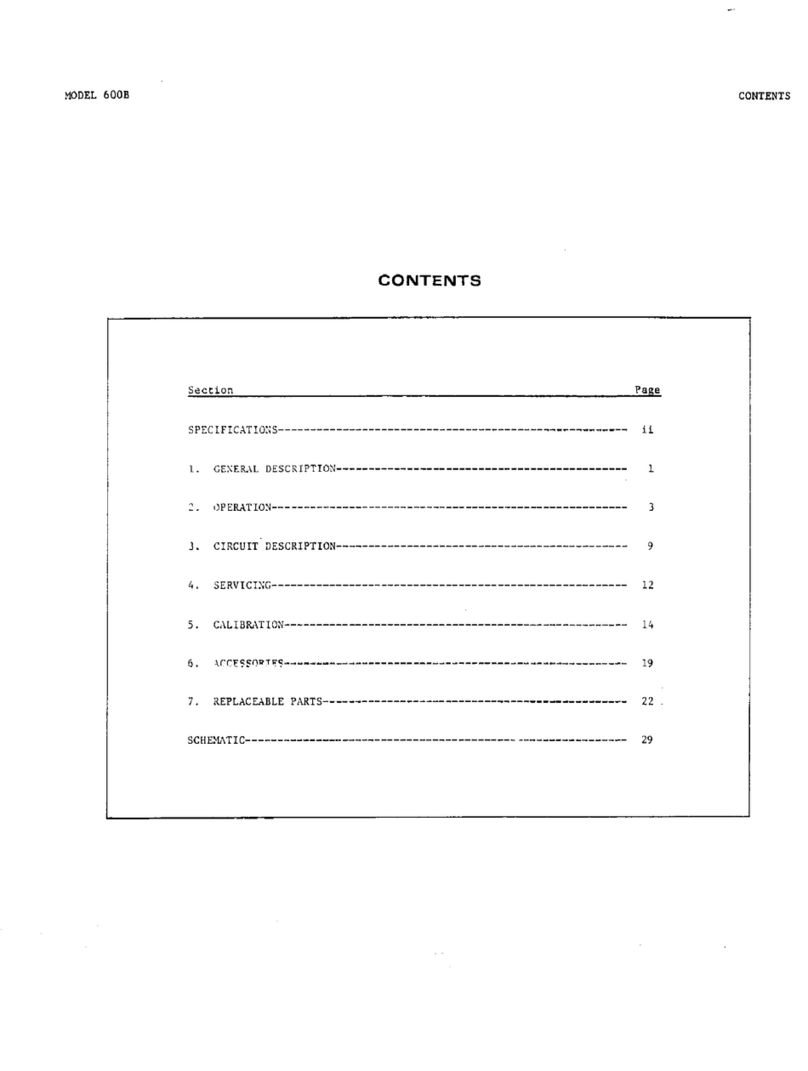
Keithley
Keithley 600B User manual
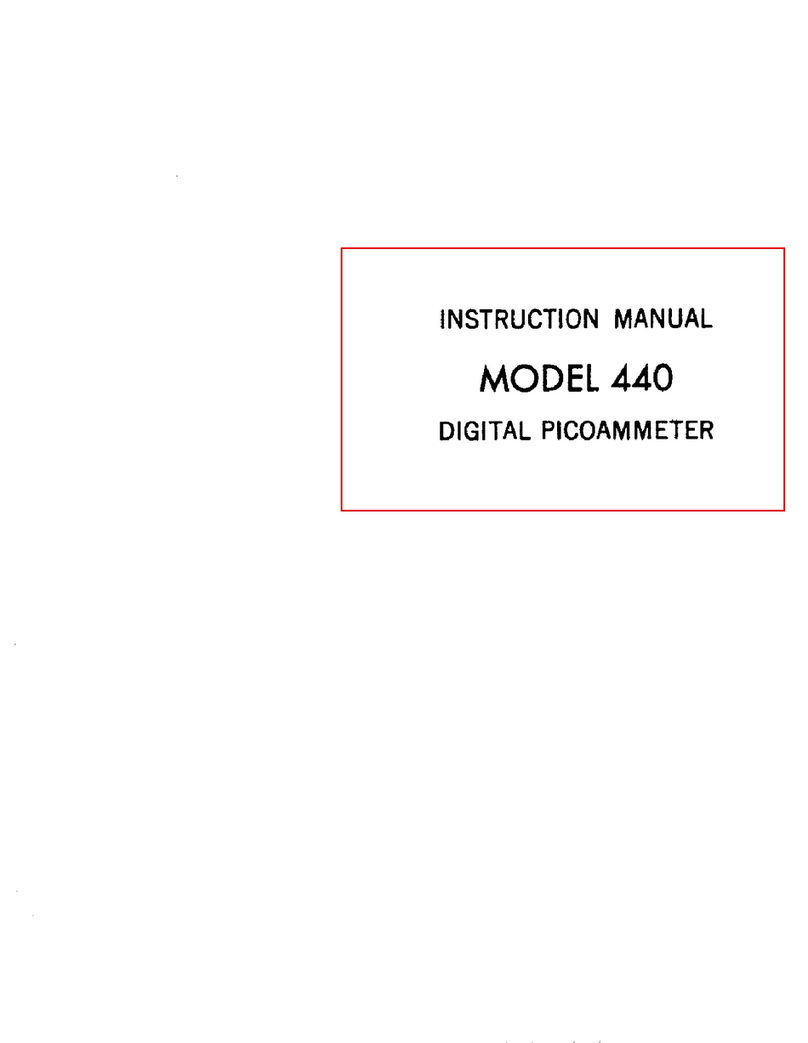
Keithley
Keithley 440 User manual
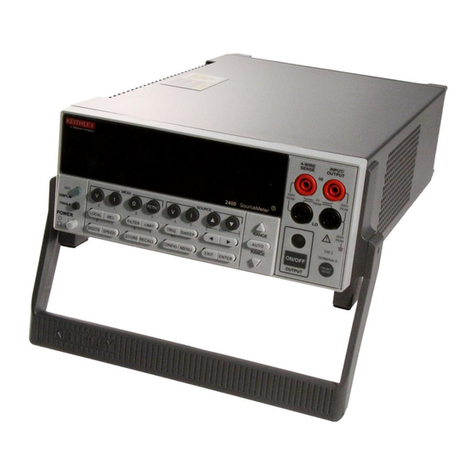
Keithley
Keithley SourceMeter 2400 User manual
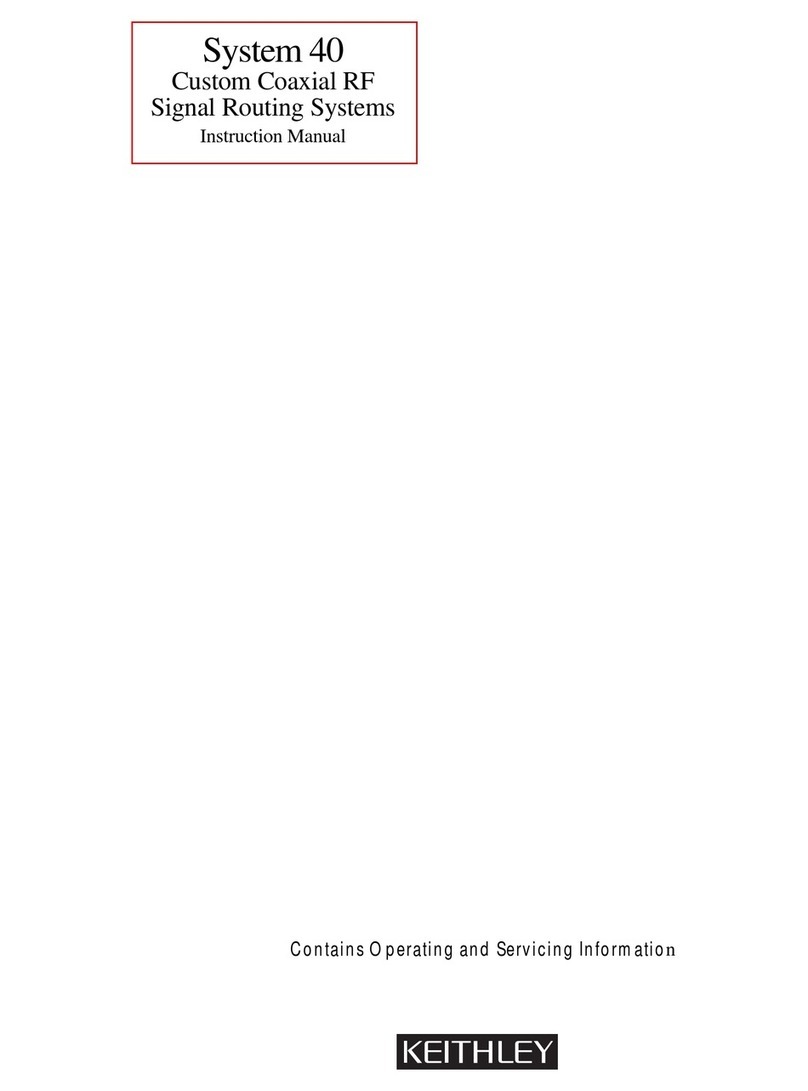
Keithley
Keithley System 40 User manual

Keithley
Keithley 2701 User manual

Keithley
Keithley 6517B User manual
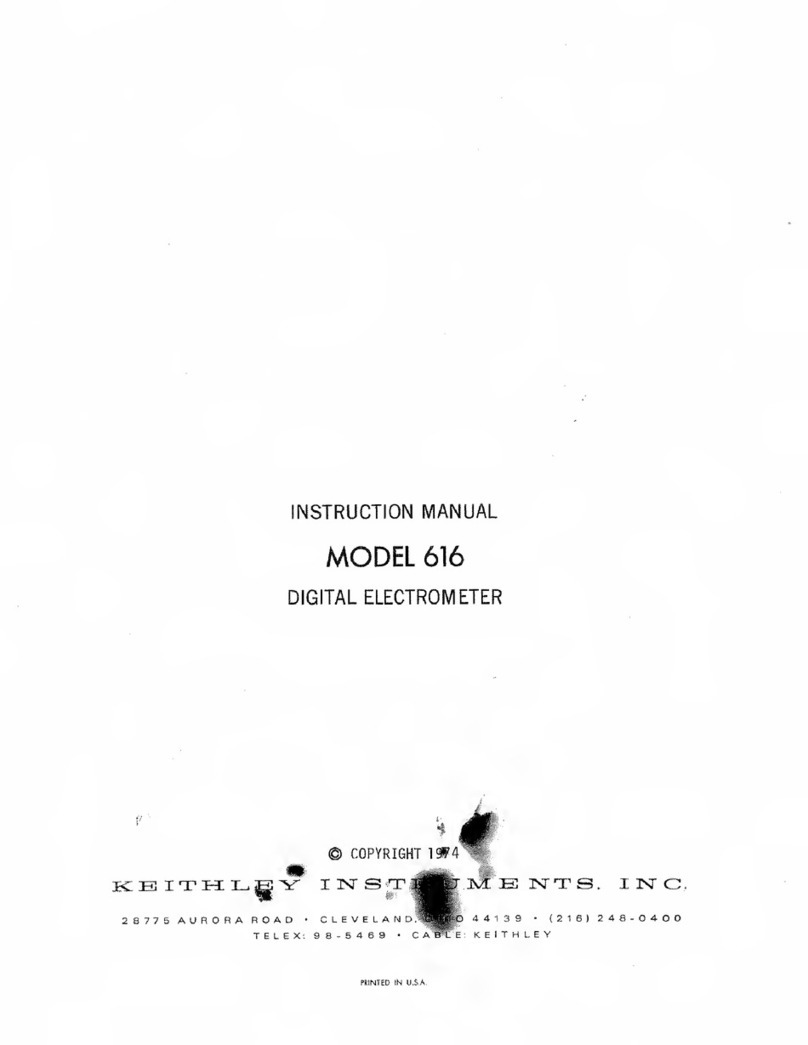
Keithley
Keithley 616 User manual
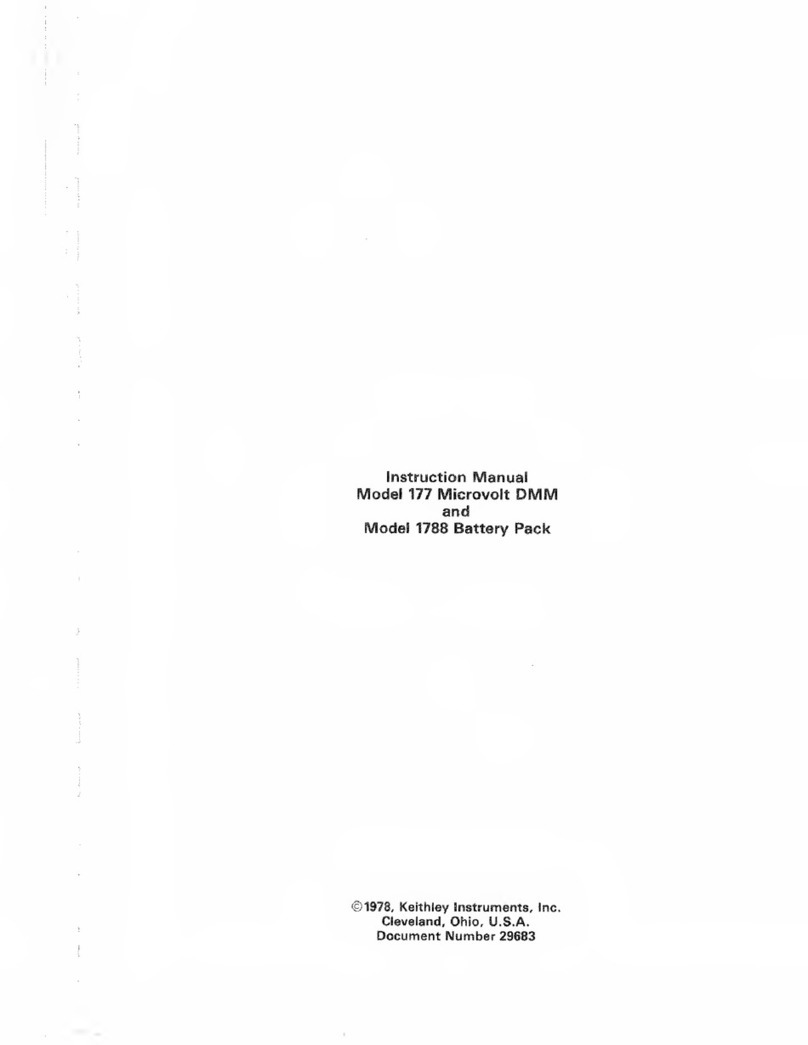
Keithley
Keithley 177 User manual
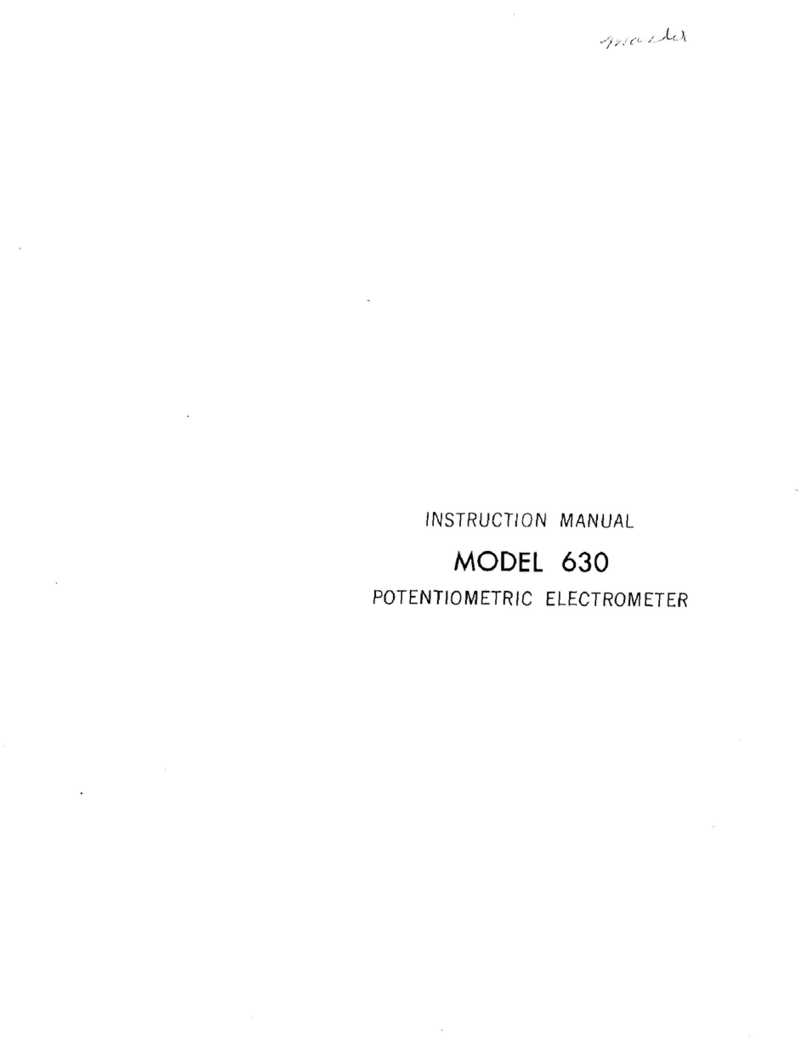
Keithley
Keithley 630 User manual
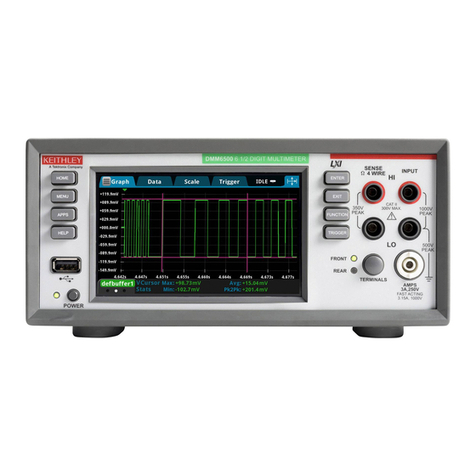
Keithley
Keithley DMM6500 User manual
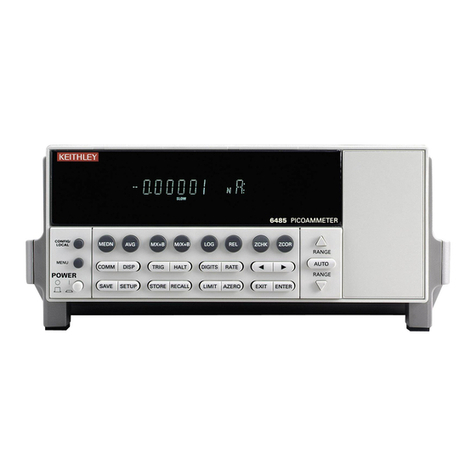
Keithley
Keithley 6485 User manual

Keithley
Keithley 590 CV User manual
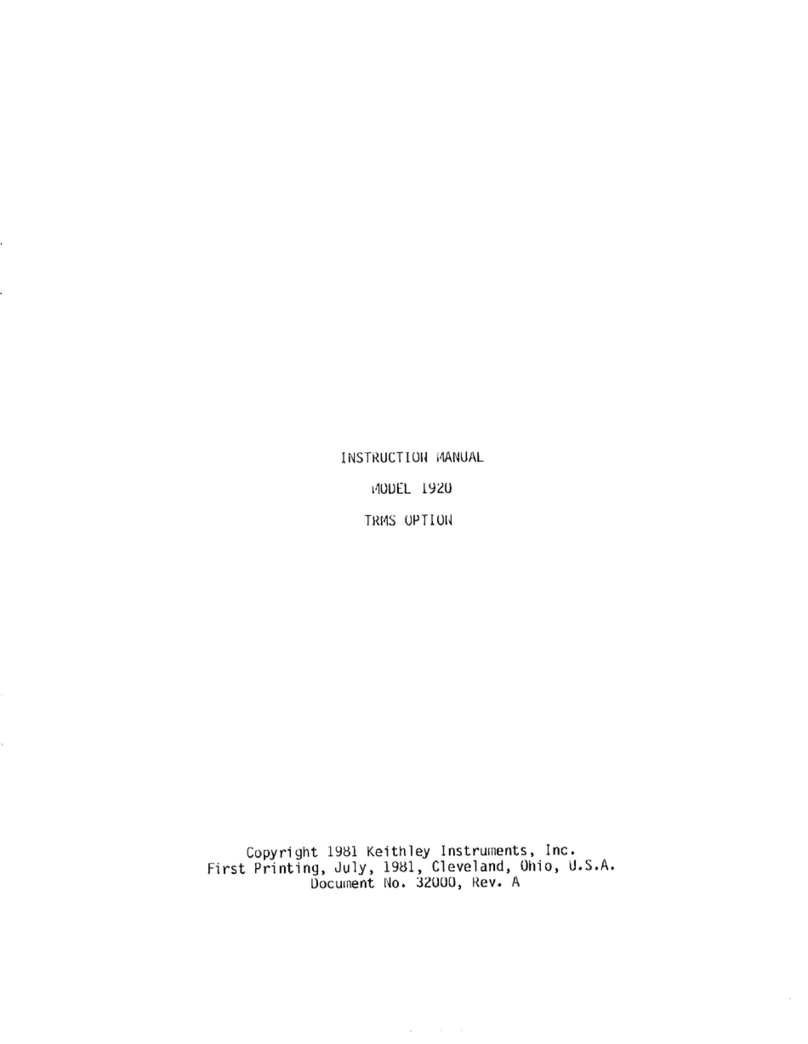
Keithley
Keithley 1920 User manual
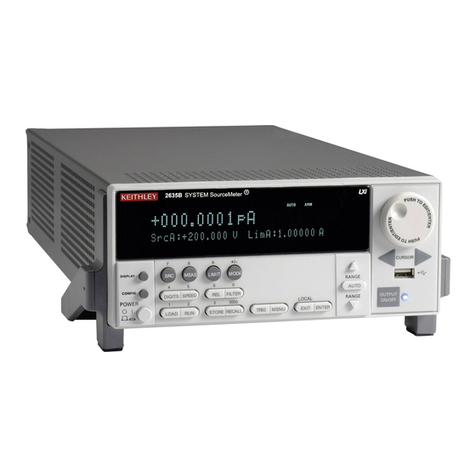
Keithley
Keithley 2601A User manual

Keithley
Keithley 2461 User manual
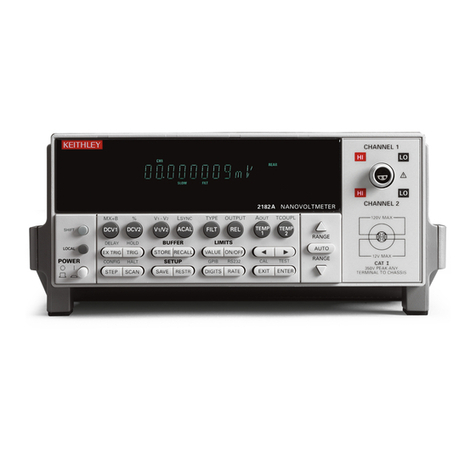
Keithley
Keithley 2182 User manual
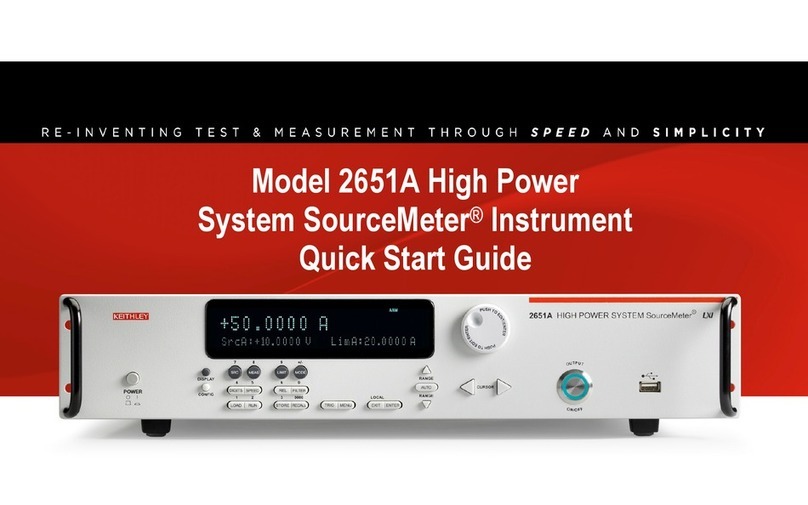
Keithley
Keithley 2651A User manual
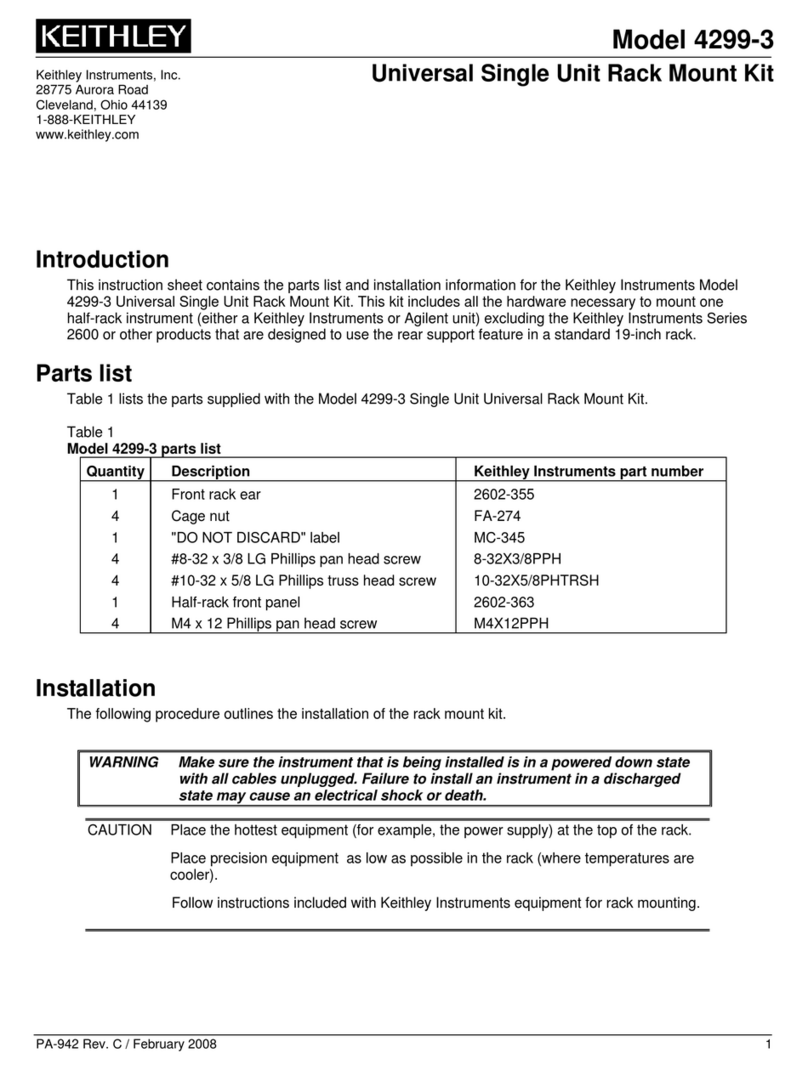
Keithley
Keithley 4299-3 User manual

